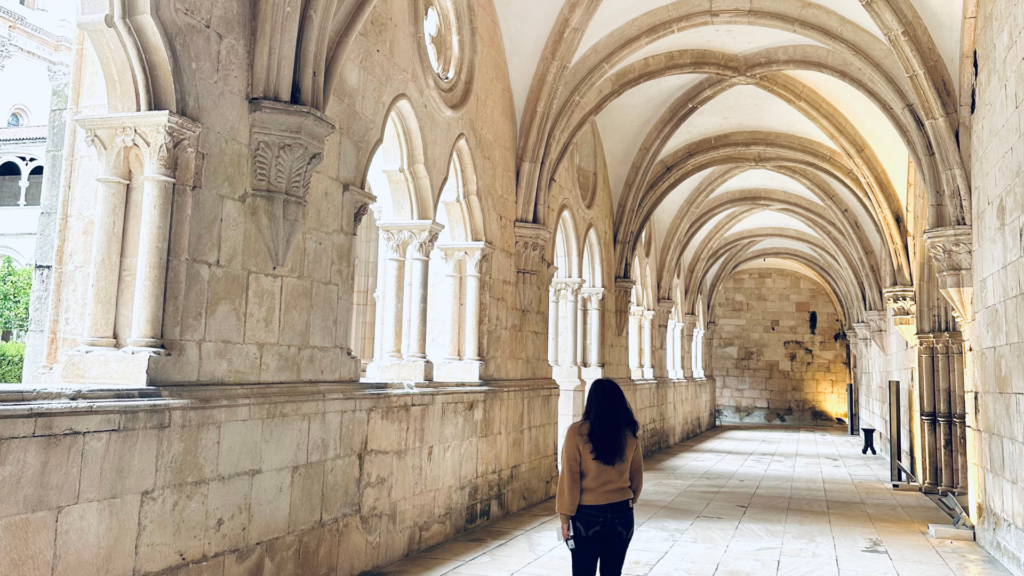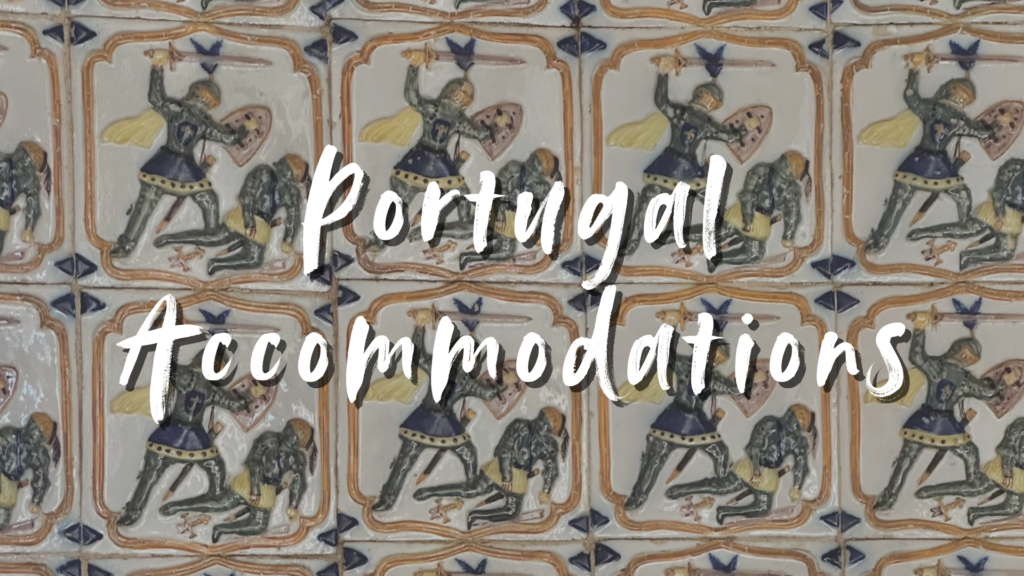Portugal, a gem of Europe, boasts stunning beaches, historic cities, delicious cuisine, and warm hospitality. From Lisbon’s charm to Porto’s wine culture, this time, I spent 6 days in Portugal then 4 days in Spain.
This itinerary will be mainly based on my own 6 day trip (actually 5 days because of early flights leaving to Madrid on the last day), including places I have originally planned but wasn’t able to visit. I have also made a few improvements based on actual experience, feel free to tweak to suit your own itinerary.
About This Itinerary
I did a road trip from Lisbon to Porto, but if you are not driving, you may want to skip Day 5. Most of the places are within walkable distance, or you may also take the trams with your Lisboa Card for free.
Here’s a quick summary of the places in this itinerary:
- Lisbon — 2 days
- Sintra — 2 days
- Alcobaça, Tomar, Coimbra & Luso — 1 day
- Porto — 1 day
Before you set off for Portugal, make sure to get the Lisboa Card! This all-in-one pass offers free or discounted entry to many attractions, unlimited public transport within Lisbon, and even free train rides to Sintra and Cascais. With different duration options available (24h, 48h, 72h), you can pick the one that best suits your itinerary and enjoy a hassle-free experience while exploring the city.
Day 1: Lisbon
Miradouro de São Pedro de Alcântara
Depending on how early / late your flight is, if you are arriving early like me (I arrived at 6am), you may want to check out one of the Lisbon’s must-see viewpoints Miradouro de São Pedro de Alcântara first, which is open 24 hours.
If you are travelling alone like me (I solo on the first day), you will probably get similar shots like these:

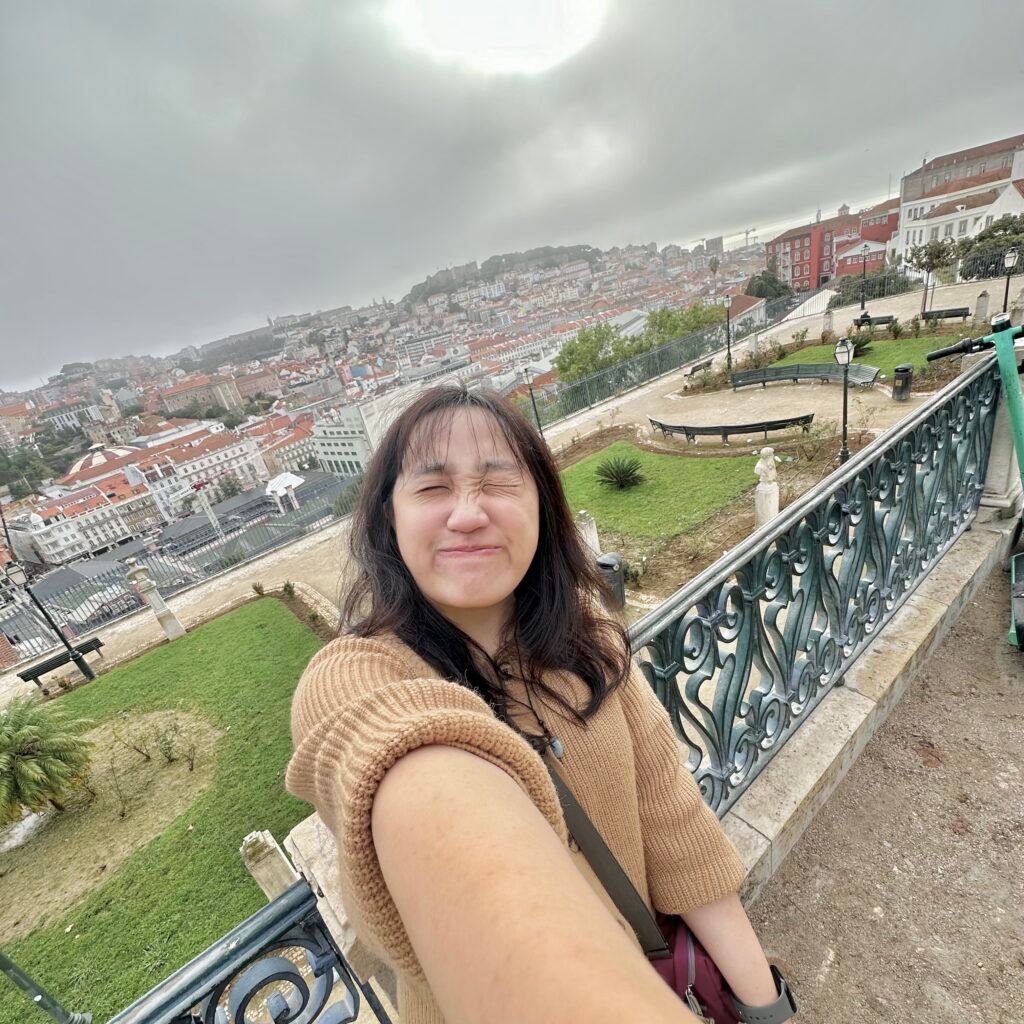
The view from the terrace is also absolutely stunning, where you will be able to see all those typical orange-red rooftop houses from here. (I honestly wish that the weather would be better and they sky could be clearer but luckily, it didn’t rain at least — so I’m already counting my blessings.


If you think that’s all — oh boy, you’re in for a surprise! Read till the end and I will share another better spot for the iconic scene in Portugal!
Neighbourhoods – Bairro Alto, Baixa & Alfama
First day of the trip, meaning that you must be tired after hours of flight. So I definitely recommend that you can spend your first day relaxing, chilling and walking around these neighbourhoods – Bairro Alto, Baixa and Alfama.
Of course there are many other neighbourhoods as well in Lisbon, but due to limited time and budget that I have when travelling Portugal, I decided to focus on these three neighbourhoods in this trip.
Bairro Alto
Literally meaning “upper neighbourhood”, Bairro Alto sits at the top of a hill. It is a lovely neighbourhood with iconic narrow cobblestone streets and medieval walls.
Rua da Bica de Duarte Belo – Tram 28
Tram 28 is Lisbon’s most iconic ride, weaving through the city’s historic heart. From the cobbled streets of Alfama to the bustling squares of Baixa, this vintage yellow tram offers a scenic journey through time. Hop on, grab a window seat, and enjoy Lisbon’s charm — but just watch out for pickpockets!
While Rua da Bica de Duarte Belo being Lisbon’s most photographed street, Tram 28 departs from here every 15 minutes until 9pm. We accidentally walked past here while wandering around the neighbourhood, not knowing that this is actually that iconic street. But the true essence of travel lies in uncovering the soul of a place through your own journey. That’s why everything you see, every hidden alley and fleeting moment, becomes a unique treasure just for you.

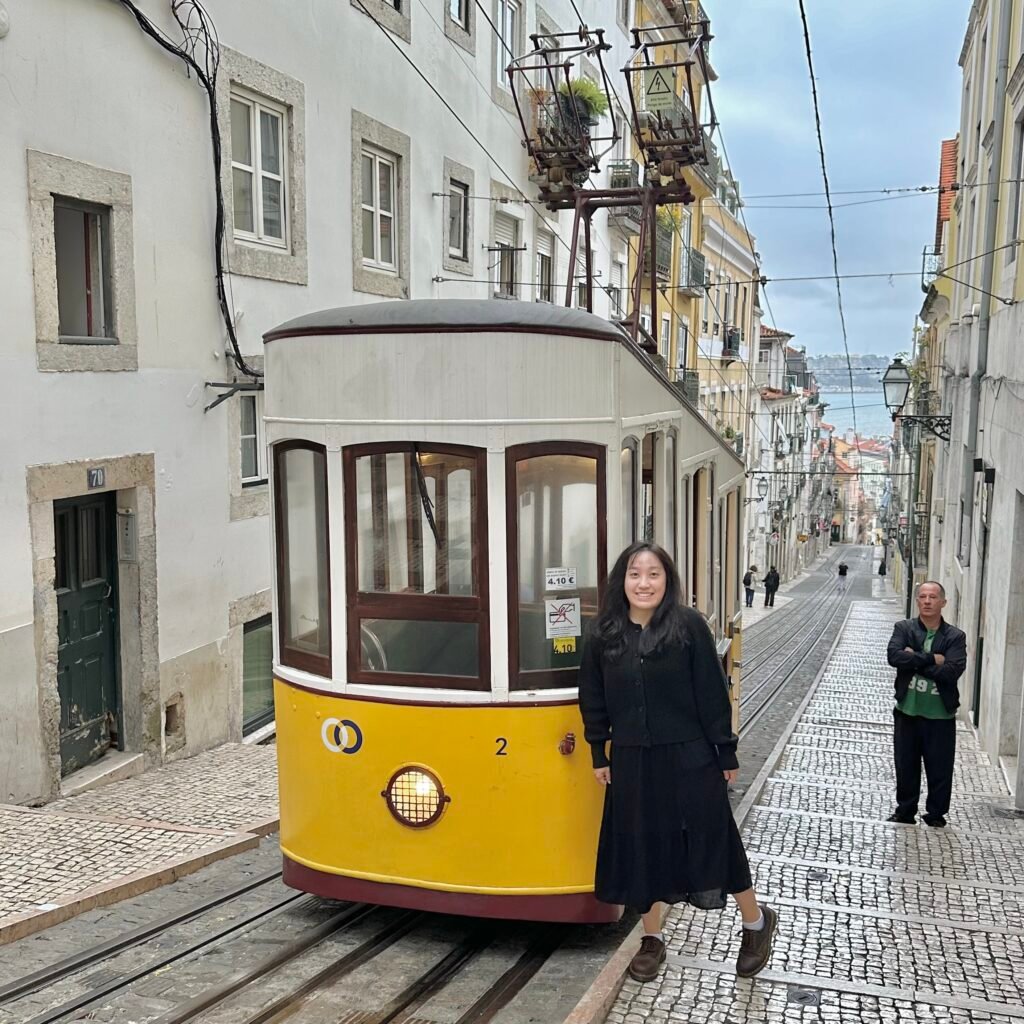
Here is the route for your reference, definitely recommend taking the tram ride especially if you are not driving, everything’s included in the Lisboa Card!
Brunch: Breakfast Lovers Misericórdia
We have the perfect division of labour, with my friend being the foodie and searched for all of the nice restaurants. Breakfast Lovers Misericórdia, which is right next to the most photographed street, is the heaven for breakfast or brunch! It boasts a cozy, homely vibe with soft neutral tones and lush greenery. Cute decorative plates hang on the walls, adding charm to the inviting atmosphere — perfect for a relaxing meal.





Do they look a bit too much for two of us? Lol. The Mac & Cheese is one of the best Mac & Cheese I have in my life. Not sure how they made it, but you can taste a bit of curry(?) and peanut(?) inside, which makes the whole dish next level. As for drinks, we ordered Cappuccino and Ginger Lemonade.
The only thing to note is that you need to get here early or be prepared to line up, since it is ALWAYS busy!
🍽️ Breakfast Lovers Misericórdia
- Address: Calçada do Combro 45, 1200-114 Lisboa, Portugal
- Hours: 8am – 4pm
Church of Saint Roch
The Church of Saint Roch is a stunning example of baroque and Renaissance architecture, with its ornate façade and richly decorated interiors. Inside, you’ll find intricate gilded altars, beautiful chapels, and impressive artwork. It’s a place where history, art, and spirituality blend to create a truly awe-inspiring experience.
We didn’t have time to visit this church at the end, however, it is just an 8-minute walk from the restaurant / Rua da Bica de Duarte Belo. The admission will be €2.50 without Lisboa Card, and €1 with Lisboa Card.
Baixa
Baixa is Lisbon’s vibrant heart, where grand squares meet bustling streets. With its neoclassical architecture, trendy shops, and cozy cafes, it’s the perfect place to stroll, shop, and soak up history.
Praça do Comércio
Starting off at Praça do Comércio, Lisbon’s magnificent riverside square, which is framed by neoclassical arches and lively cafes. Nearby, charming streets lined with indie shops along The Rua Augusta, boutiques, and hidden gems offer the perfect escape to explore Lisbon’s eclectic style. It’s an ideal spot to relax, shop, and enjoy the breathtaking views of the Tagus River.
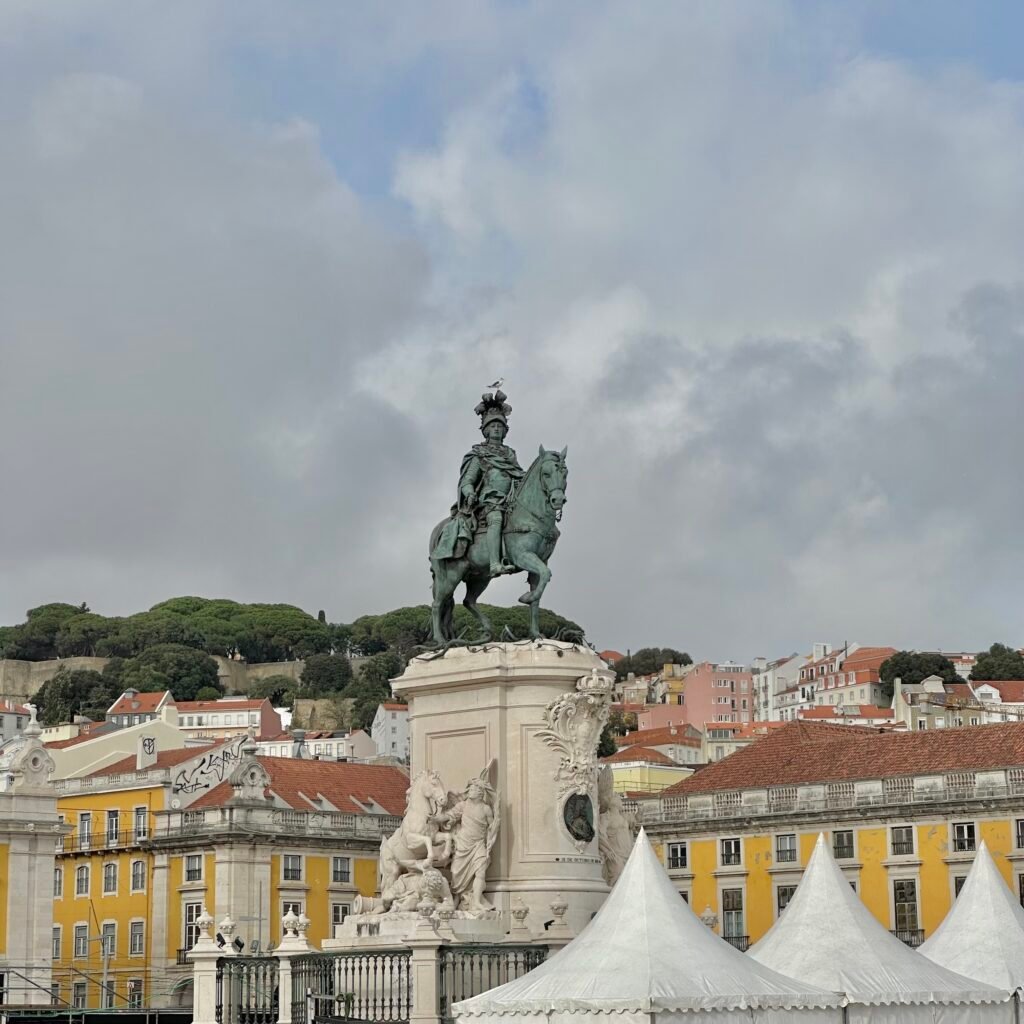
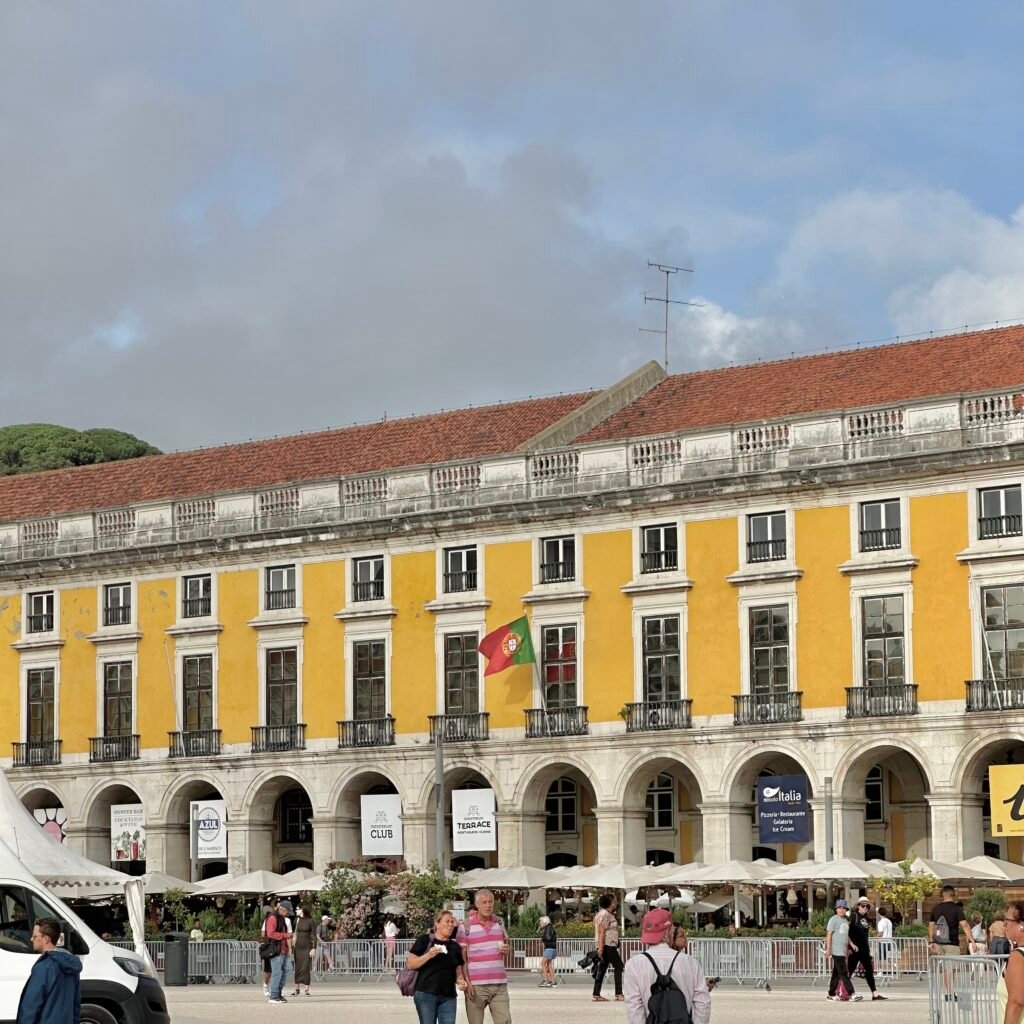

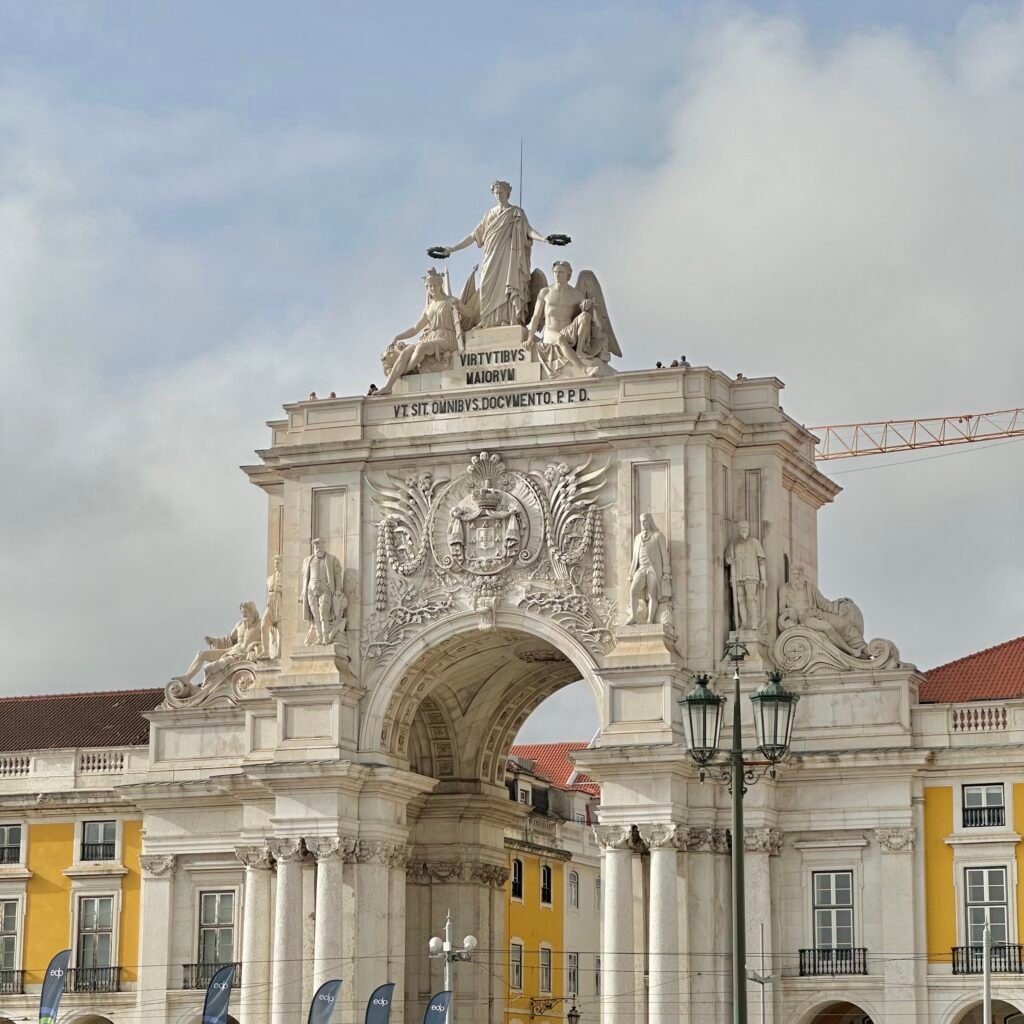
On the last day staying in Lisbon, we also happened to stumble upon the Lisbon Marathon in full swing, with the finishing point at this plaza — what a surprise!
Santa Justa Elevator
Walking and shopping along the streets from Praça do Comércio, you will then see the Santa Justa Lift, which is an elevator in Lisbon and is the fastest way to get from the Baixa neighborhood to the Bairro Alto district.

I guess we got here too early that day, no one was queuing nor standing there, so we thought that it wasn’t operating and chose to climb up to the Carmo Convent.
Only later when we passed by again and saw the long queue did we realize that it was actually operating. We didn’t try the lift, but it is included in the Lisboa Card and you can ride it for free, so you should definitely give it a try!
The only thing to note is that it will get super busy due to the limited capacity (25 people), so it is recommended to ride it early in the day (before 9:30am) or late in day (30 minutes after sunset until closing time).
Carmo Convent
If you are taking the Santa Justa Elevator, then you will immediately see the Carmo Convent walking out of the walkway. Carmo Convent, a stunning Gothic ruin in the heart of Lisbon, offers a glimpse into the city’s past. Its open-air interior, with towering arches, creates a hauntingly beautiful atmosphere.

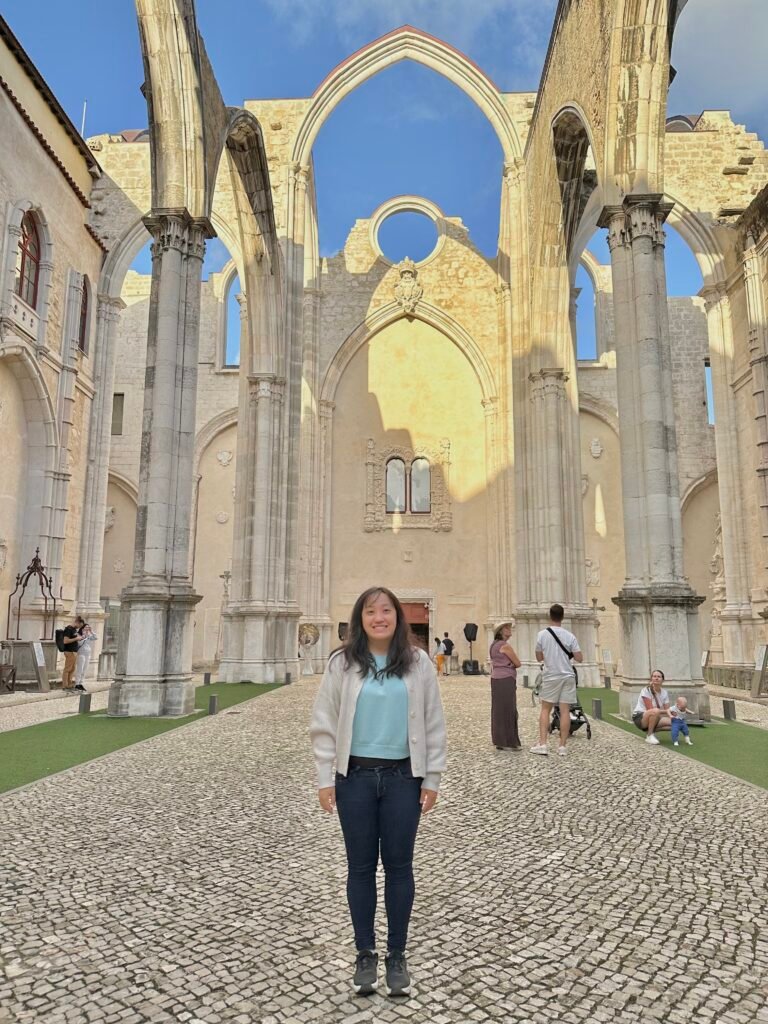
Stepping into the Carmo Convent, I was instantly in awe — its towering arches stand defiant, whispering tales of resilience. Though shaken by earthquakes, its beauty endures, a hauntingly poetic tribute to time.
Opening Hours & Admission
Admission ticket for Carmo Convent is €5, free of charge if you have the Lisboa Card with you. Opening hours are 10am – 6pm.
Secret Phototaking Spot
You should definitely also check out the viewpoint in between the Santa Justa Elevator and Carmo Convent! Search “Casa Portuguesa do Pastel de Bacalhau – Elevador Sta. Justa” on Google Map and you will reach this secret photo-taking spot!


Alfama
Alfama, Lisbon’s oldest district, is a maze of narrow streets, colorful tiles, and soulful fado music. With stunning viewpoints and hidden gems, it’s a place where history and charm come alive.
It is, again, another neighbourhood in Lisbon, where you can walk around the whole day and enjoy the views of Lisbon.
Castelo de São Jorge
If you still have time, you may also want to visit the Castelo de São Jorge near sunset. Castelo de São Jorge is roughly 20-minute walk / 16-minute tram ride from Carmo Convent. Still remember the best spot for the iconic Lisbon scene I mentioned earlier? Ta-dah! Here we are!
Castelo de São Jorge crowns Lisbon with its ancient walls and breathtaking views. Strolling through its battlements, you’ll uncover centuries of history while soaking in panoramic sights of the city and river.


On the day of visit, it happened to be the marathon day. Roads were blocked and the traffic was terrible for driving. I am not sure if it is similar on any other days, apart from this, also make sure that you bring a jacket with you since it gets quite windy up there (as you already see from my pictures haha)!
Opening Hours & Admission
Admission ticket for Castelo de São Jorge is €15, free of charge if you have the Lisboa Card with you. Opening hours are 9am – 6pm.
Dinner: Cervejaria Ramiro
Cervejaria Ramiro is Lisbon’s seafood paradise, famed for its fresh prawns, clams, and juicy garlic butter-drizzled lobster. A lively, no-frills spot where every bite is pure ocean-flavored bliss! We went there at around 3:30pm, but still filled with long queues outside the restaurant. I would recommend you to go there a bit earlier, so that you don’t have to wait for too long!

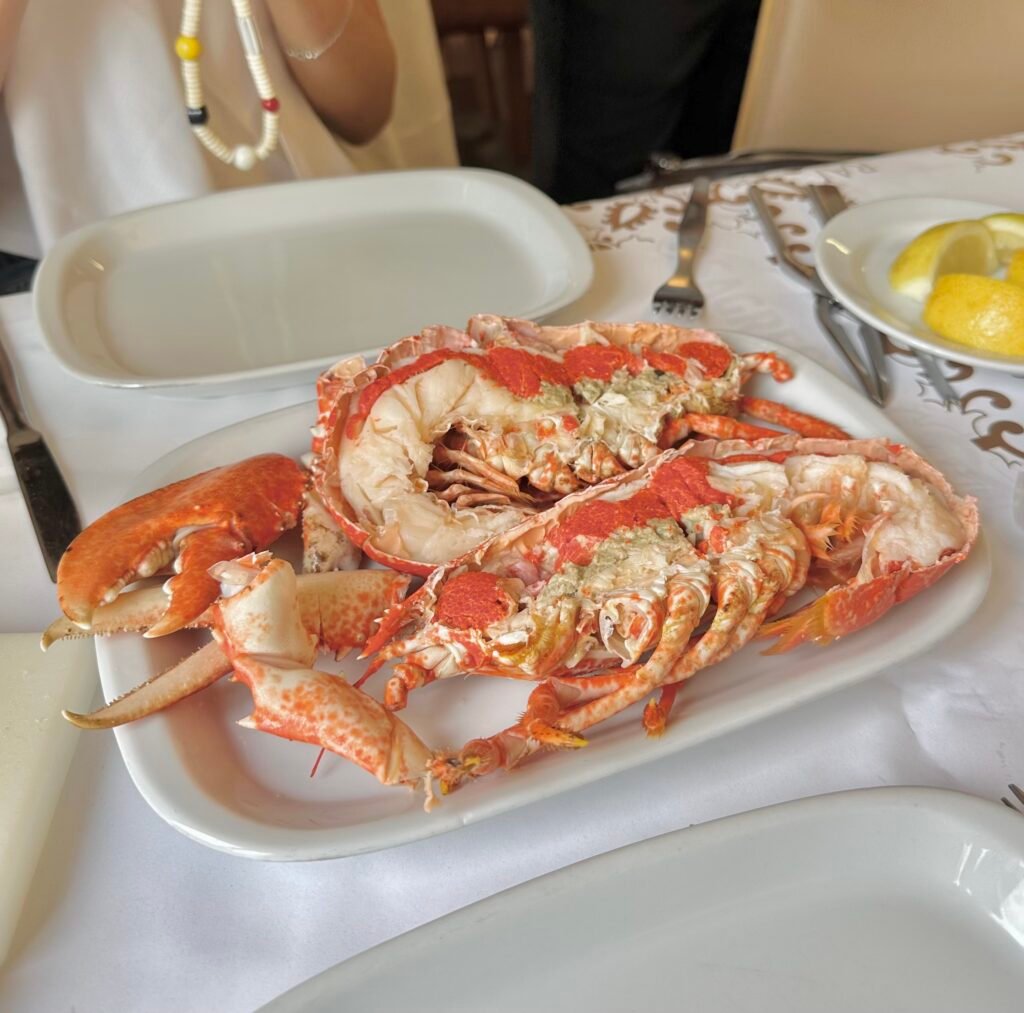

The Scarlet Shrimp was rich and buttery, with a deep umami flavor in its head. The Lobster, drenched in garlicky butter, was juicy and tender. The Spider Crab was sweet, its creamy roe an indulgent treat. Even the simple bread with butter tasted heavenly, perfect for soaking up every last drop of seafood goodness!
🍽️ Cervejaria Ramiro
- Address: Av. Alm. Reis 1 H, 1150-007 Lisboa, Portugal
- Hours: 12pm – 12am
Snacks: Time Out Market
In case you are hungry at night, you might also want to go check out the Time Out Market, which is 12-minute walk from Praça do Comércio (the plaza).
Day 2: Lisbon – Belem
25 April Bridge – Pilar 7 Bridge Experience
The 25 de Abril Bridge, Lisbon’s striking red suspension bridge, spans the Tagus River, often compared to San Francisco’s Golden Gate. Named after Portugal’s Carnation Revolution of April 25, 1974, it symbolizes freedom and change. Whether admired from the waterfront or crossed by car, its grandeur and views never disappoint.
The Pilar 7 Bridge Experience offers a unique behind-the-scenes look at Lisbon’s iconic 25 de Abril Bridge. This interactive museum features immersive exhibits on its engineering, virtual reality experiences, and a panoramic glass-floored viewpoint towering over the Tagus River.
Opening Hours & Admission
Admission ticket for Pilar 7 Bridge Experience is €5.50, free of charge if you have the Lisboa Card with you. Opening hours are 10am – 5pm.

Cristo Rei Statue
Crossing the 25 de Abril Bridge, you’ll be greeted by the towering Cristo Rei Statue (see above picture), standing proudly over Lisbon. Offering breathtaking panoramic views of the city and Tagus River, this monumental landmark, inspired by Rio’s Christ the Redeemer in Brazil, is a powerful symbol of faith, peace, and gratitude.

It will be a roughly 10-minute drive from the 25 April Bridge, or you may also take a ferry from the Cais do Sodré terminal to Cacilhas. A single ferry ticket costs €1.50, the whole journey will take approximately less than 45 minutes, including a bus ride from the ferry terminal at Cacilhas to the Cristo Rei Statue.
Pastéis de Belém
Pastéis de Belém is the birthplace of Lisbon’s legendary custard tarts, made from a secret recipe dating back to 1837. Originally created by monks from the nearby Jerónimos Monastery (the next spot to visit), these golden delights feature flaky, crispy layers and a rich, creamy filling. Freshly baked daily, they’re best enjoyed the traditional Portuguese way—with a sprinkle of cinnamon for extra warmth and flavor. A must-try taste of history!
There are two queues at the store, one for dine-in, and another for take-away. We arrived at around 7:30pm on a Sunday, and the queues are SUPER long! I’d suggest arriving in the morning, when the crowds are still a whisper. This way, you can skip the queues and savor each bite unhurried, letting the flavors linger a little longer.



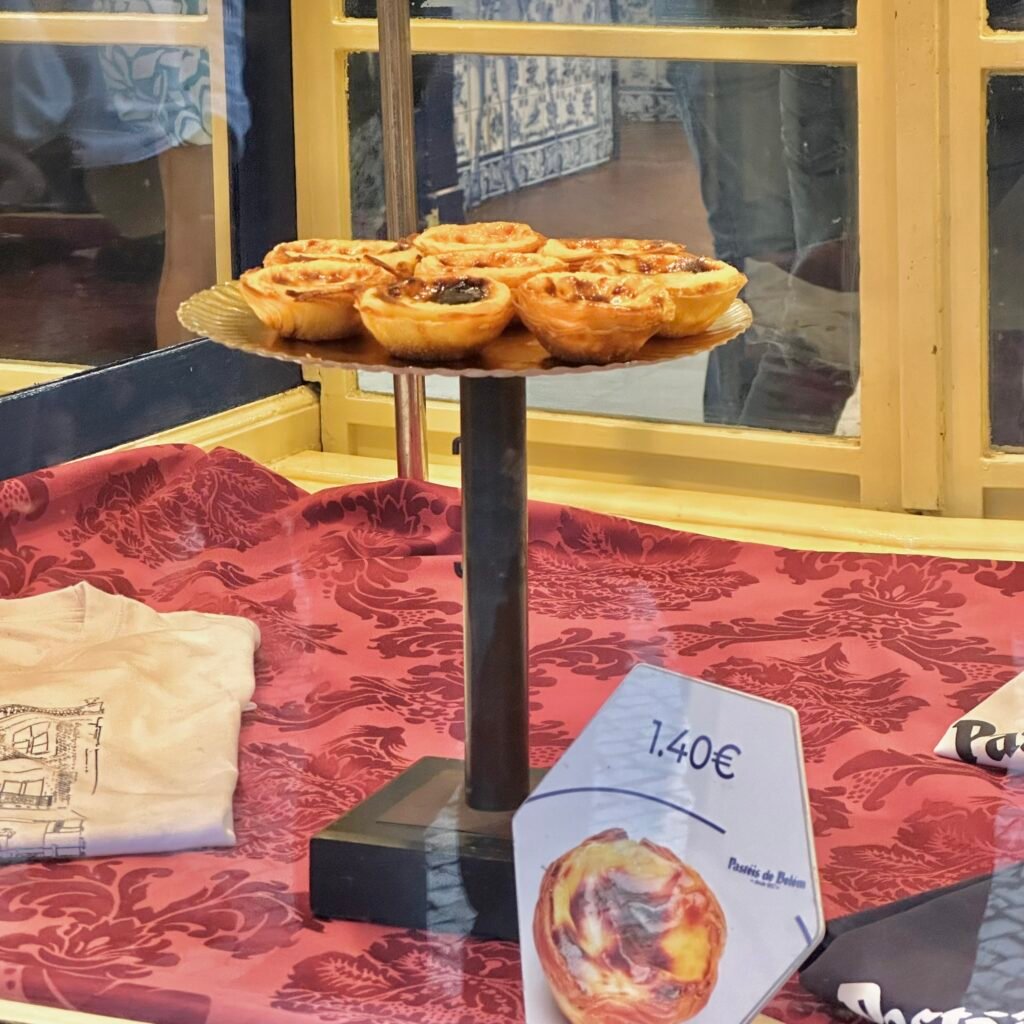
It costs €1.40 each, coming along with a take-away box if you ordered take-away. We ordered 4 tarts and enjoyed them in the car, still warm from the oven. With each bite, the crisp, flaky crust gave way to a silky, creamy filling, perfectly balanced in sweetness. It was pure bliss—rich, comforting, and impossible to eat just one!


🍽️ Pastéis de Belém
- Address: R. de Belém 84 92, 1300-085 Lisboa, Portugal
- Hours: 8am – 9pm
Jerónimos Monastery
The Jerónimos Monastery is a masterpiece of Manueline architecture, featuring ornate stone carvings, intricate cloisters, and grand facades. With its Gothic and Renaissance influences, it reflects Portugal’s Golden Age of Exploration. A UNESCO World Heritage site, this stunning monument exudes history and artistry, making it a must-visit in Lisbon. It’s also the birthplace of the famous Pastéis de Belém, created by monks from the monastery in the 19th century.
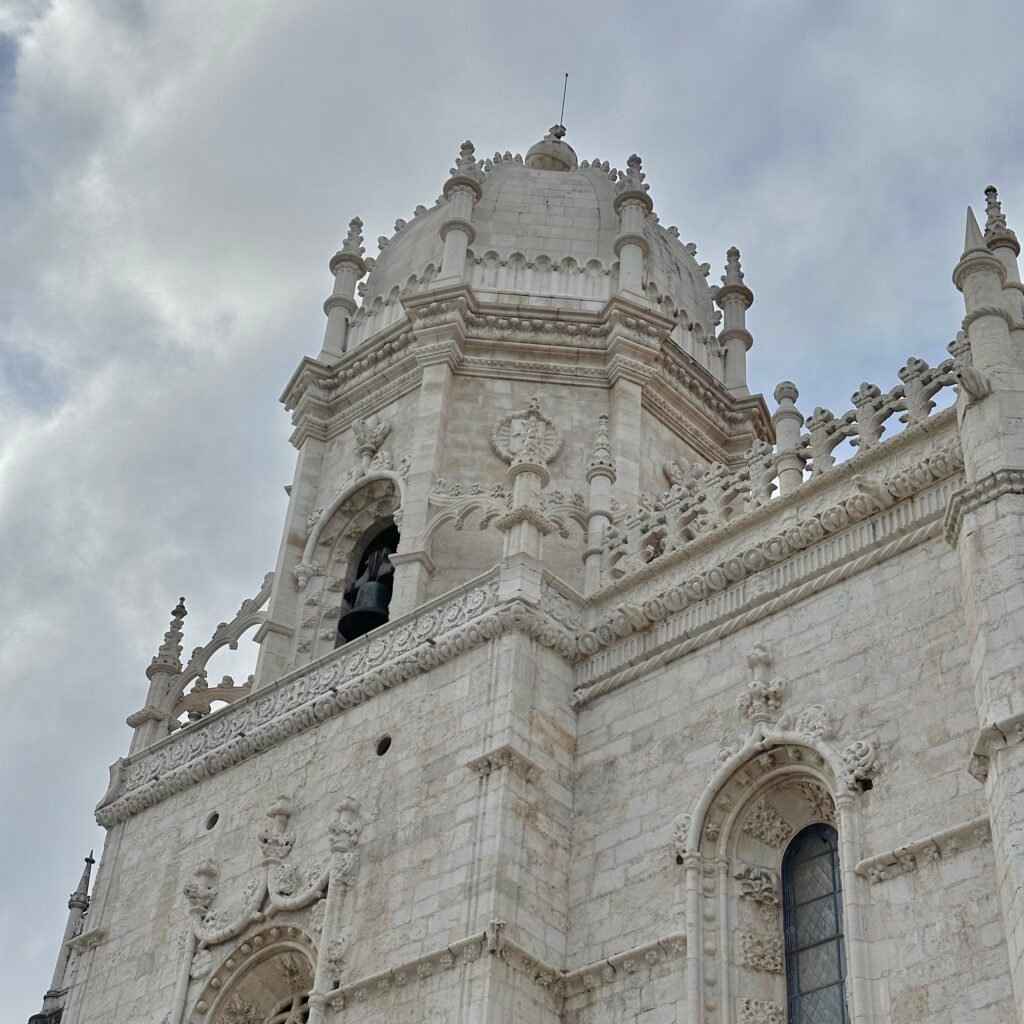
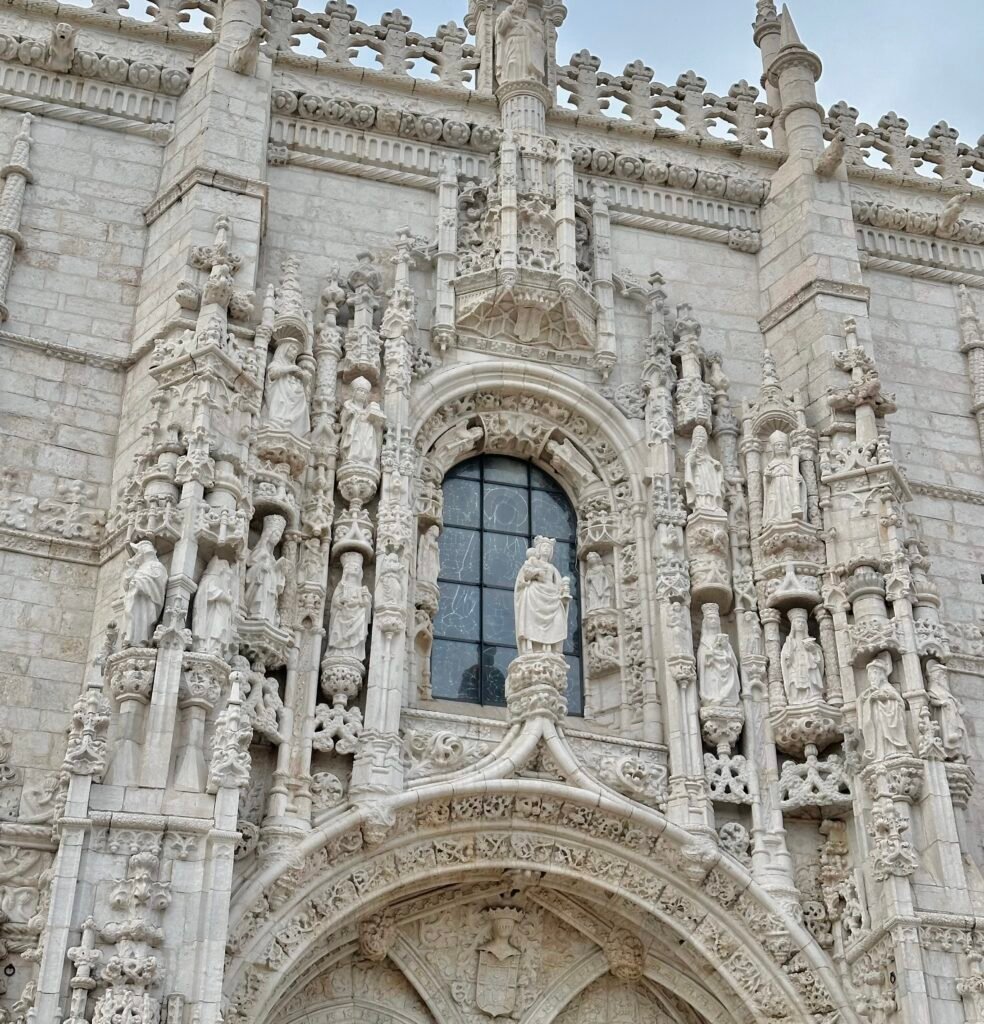
Opening Hours & Admission
Admission ticket for Jerónimos Monastery is €10 for adults, free of charge if you have the Lisboa Card with you. It is open Tuesdays to Sundays, between 9:30am – 6pm, where the last admission is at 5:30pm. We weren’t aware of the last admission time during our trip, and sadly, we missed it. Please make sure to visit on my behalf and soak in all the beauty for me!
However, there’s a lovely garden outside the monastery, where you can unwind and relax while watching the ducks. It’s a peaceful spot to enjoy the tranquility, even if we missed the inside!
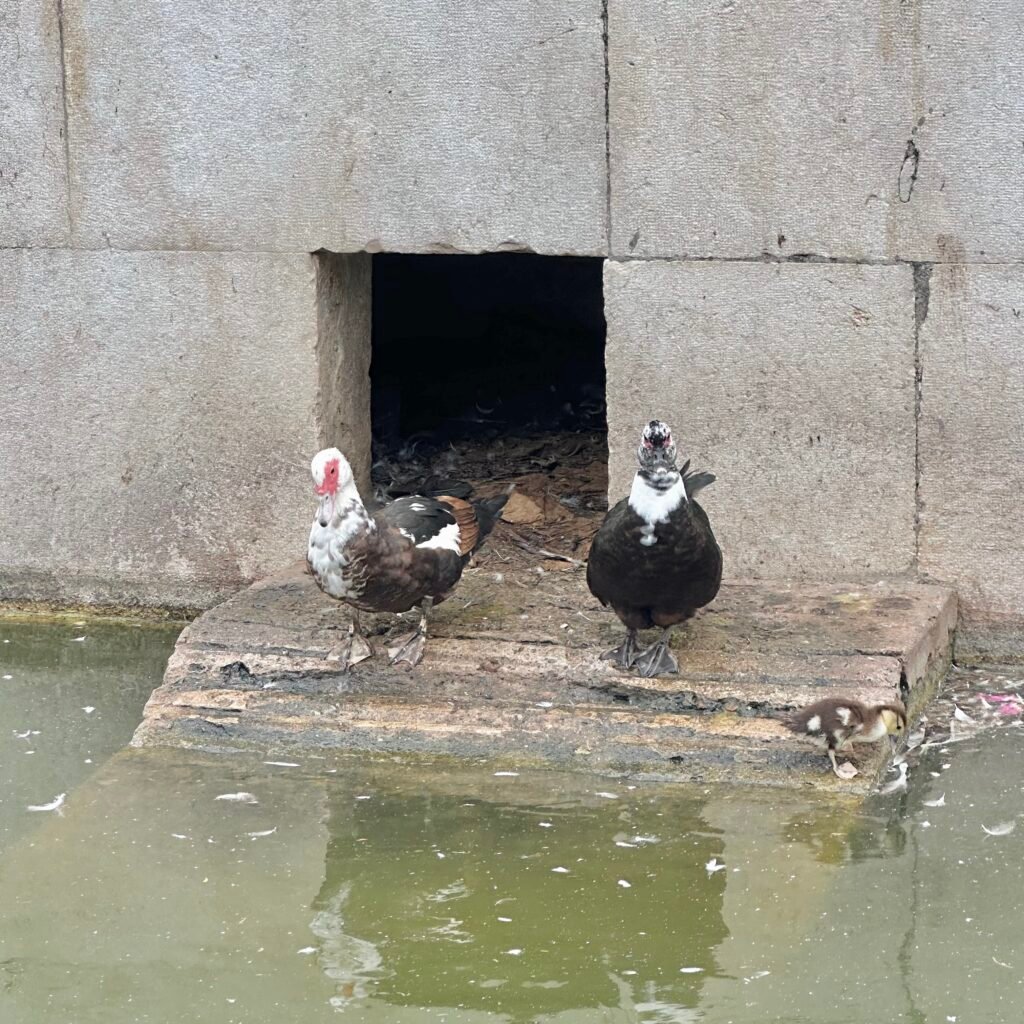
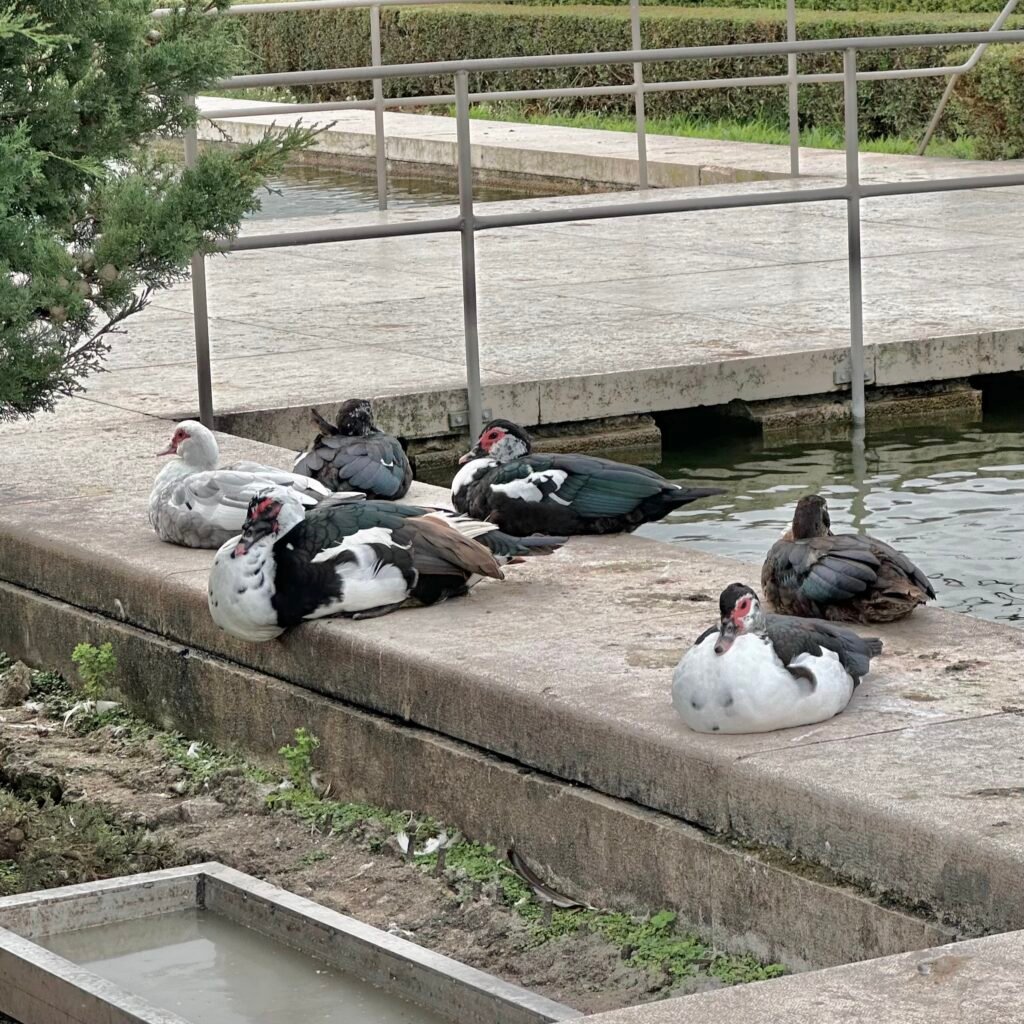
Given its impressive scale, it’s impossible to fully take in the monastery’s architecture in one glance. However, you can admire its grandeur from the nearby Monument to the Discoveries, offering a perfect panoramic view!

Monument to the Discoveries
The Monument to the Discoveries honors Portugal’s greatest explorers, with Infante Dom Henrique at the forefront. This impressive structure celebrates the Age of Exploration, offering stunning views of the Tagus River and showcasing statues of iconic figures like Vasco da Gama.
Standing at the front of the Monument to the Discoveries is Infante Dom Henrique, also known as Henry the Navigator. He was a Portuguese prince and key figure in the early days of the Age of Discovery, supporting exploration and the development of navigation that led to Portugal’s maritime empire.


As you ascend the Monument to the Discoveries, the view becomes even more breathtaking. From the top, you can gaze across the Tagus River, where shimmering waters meet the sky. Lisbon’s iconic skyline stretches out before you, with the 25 de Abril Bridge gracefully arching in the distance. The majestic Cristo Rei Statue stands proudly across the river, offering a serene presence. The lush greenery of Belém and the historic Jerónimos Monastery complete the picturesque scene, making the panorama a truly stunning sight—an unforgettable way to witness the city’s beauty from above.

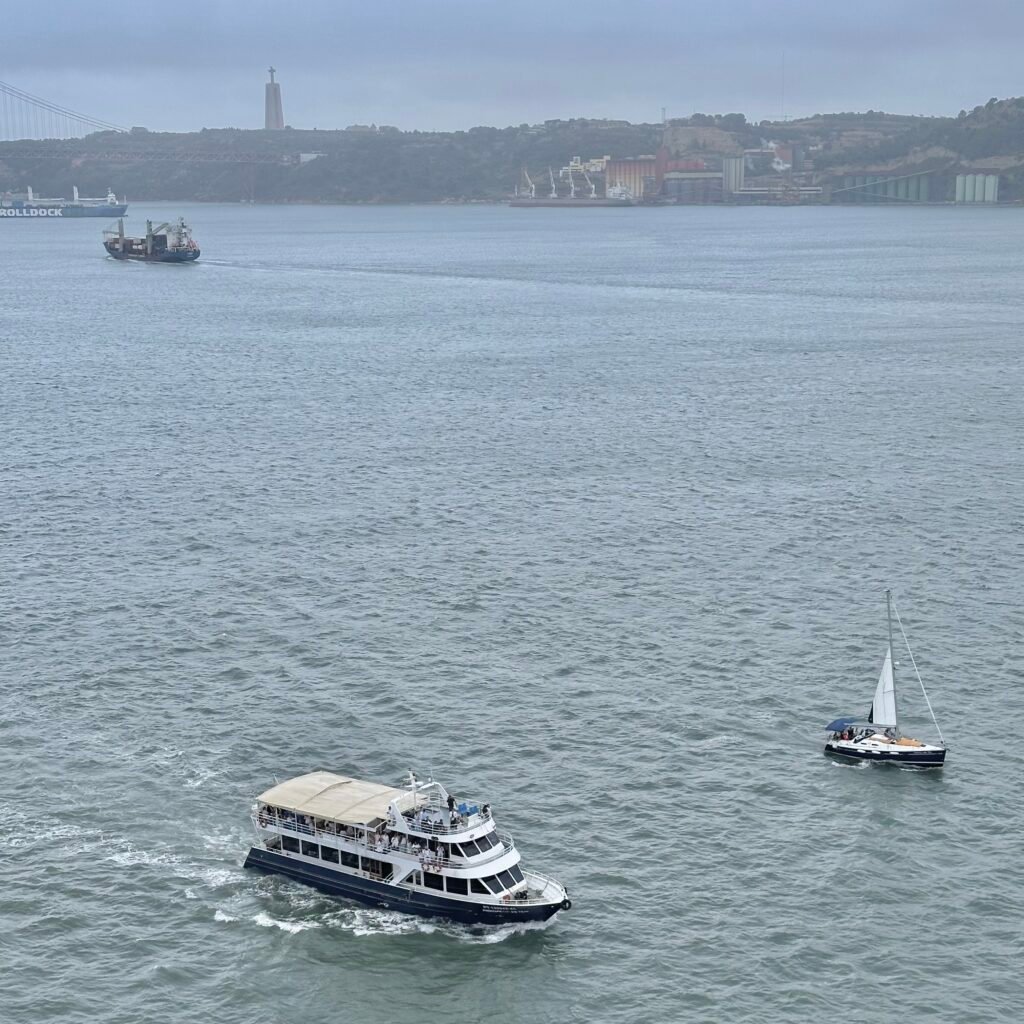
Opening Hours & Admission
Admission ticket for the Monument to the Discoveries is €10 for adults, free of charge if you have the Lisboa Card with you. The opening hours of the Monument to the Discoveries vary depending on the season. In the winter, it opens between 10am – 6pm, with the last admission time at 5:30pm. While in the summer, it opens an hour longer between 10am – 7pm, with the last admission time at 6:30pm. Be sure to check ahead before planning your visit! Luckily, we arrived at 6pm during the summer, so we had time to explore Belém and didn’t miss out on everything.
Belém Tower
Walking along the Tagus River, the gentle breeze guiding your way, you’ll eventually arrive at the Belém Tower. Standing tall and proud by the water’s edge, this iconic fortress whispers tales of Portugal’s maritime past, offering a perfect blend of history and breathtaking views.
Once guarding the entrance to Lisbon’s harbor during the Age of Exploration, Belém Tower boasts stunning Manueline architecture that reflects Portugal’s maritime legacy. As a UNESCO World Heritage site, it stands proudly as a symbol of the country’s great naval history and enduring global influence.


Opening Hours & Admission
Admission ticket for Torre de Belém is €6 for adults, free of charge if you have the Lisboa Card with you. It is open from Tuesdays to Sundays, between 10am – 5:30pm, where the last admission is at 5pm. Once again, we also missed the Belém Tower because we didn’t catch the last admission time! Make sure to get there early and experience these iconic landmarks for us. Let us know once you’ve visited — we can’t wait to hear all about your experience!
With most places in Belém closing early, we opted to drive to Sintra for the stay on Day 2. This gave us the perfect chance to unwind, get a good night’s rest, and recharge for the enchanting sights and experiences waiting for us in Sintra the next day! I’ll also be rating all of the stays we booked during this trip here, so make sure to check them out if you’re looking for a trip with great value for money! You won’t want to miss these gems.
Day 3: Sintra
Sintra, a magical town just outside Lisbon, is known for its enchanting palaces, lush gardens, and whimsical atmosphere. From the colorful Pena Palace to the Moorish Castle, the town’s rich history and dramatic landscapes make it a UNESCO World Heritage site and a must-visit for any traveler.
A majority of tourists visit Sintra as a day trip, and we did the same too. However, I’d say it can feel a bit rushed, especially if you don’t drive. Even with a car, we couldn’t explore all the castles in Sintra. To truly immerse yourself in the town’s charm and history, we HIGHLY recommend spending two days here.
National Palace of Pena
The National Palace of Pena is a masterpiece of 19th-century architecture, blending Gothic, Renaissance, and Manueline styles. Originally a Moorish castle, it was transformed into a royal palace by King Ferdinand II. Perched high on a hill, its vibrant colors and whimsical design make it stand out against the lush Sintra landscape. Inside, the intricate details and royal history are just as captivating. With panoramic views of the surrounding forests and town, this fairy-tale palace is a must-see for anyone visiting Sintra!


The vibrant red and yellow colors of the National Palace of Pena were chosen by King Ferdinand II to reflect the romantic, eclectic style he wanted for the palace. These bold hues were meant to stand out against the lush green landscape of the surrounding park and symbolize the creativity and grandeur of the era. The bright red represents strength and power, while the yellow adds warmth, creating a striking visual contrast that makes the palace look like something straight out of a fairy tale.


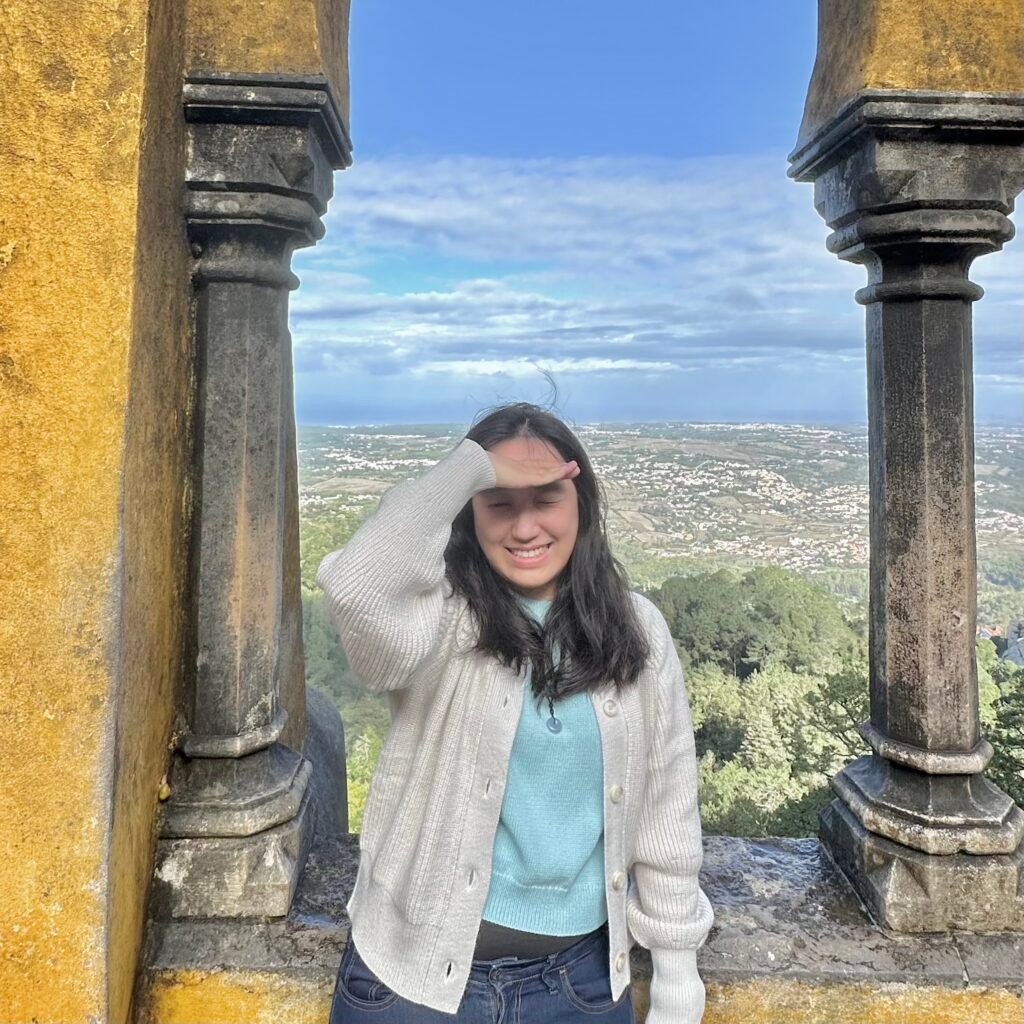
Opening Hours & Admission
The National Palace of Pena opens between 9am – 6:30pm, with the last admission time at 6pm. The admission ticket are timed, unless you are booking a guided tour. You can purchase your tickets for €20 here, and get a 15% discount if you purchase at least 3 days in advance.
As one of the most iconic castle in Sintra, the National Palace of Pena can get quite crowded, so I highly recommend purchasing the earliest ticket (9:30am) ONLINE. This will not only save you time but also allow you to explore the palace at a more relaxed pace, without the crowds. It’s definitely worth the early start!
We tried to save a bit with the 10% discount from the Lisboa Card, but that meant buying tickets at the ticket office and the nearby timeslots sold out fast. We ended up waiting for hours to get in. Trust me, it’s worth booking the earliest ticket online, even without the Lisboa Card discount — definitely save yourself the hassle and time! (Plus you will get 15% off purchasing 3 days in advance, so why not?)
The Moorish Castle
The Moorish Castle in Sintra is a captivating historical site that dates back to the 8th century. Perched high on a hill, it offers breathtaking panoramic views of the town and the lush surrounding landscape. Its ancient walls, towers, and rich history make it a must-visit spot for any traveler.
To truly experience the Moorish Castle, be prepared for a lot of walking and climbing narrow battlements. It’s an adventure that requires a good level of fitness, so it’s best suited for those who are physically fit and healthy. However, the effort is worth it for the stunning views!
We didn’t have enough time to enter the castle and do the full climb, but I still circled the castle and walked along a short path. Even from there, the views were absolutely breathtaking, offering a stunning glimpse of Sintra and the surrounding landscapes.
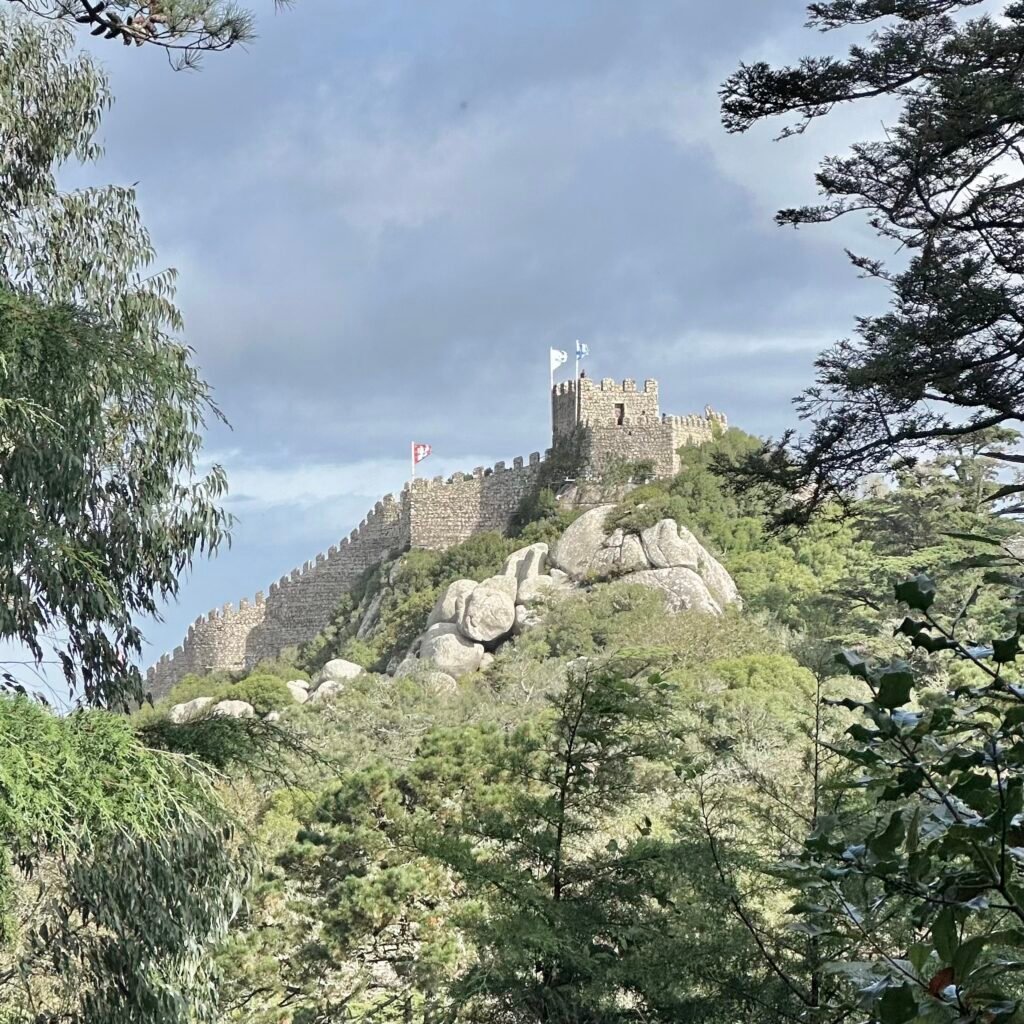

Opening Hours & Admission
The Moorish Castle opens between 9:30am – 6pm, with the last admission time at 5:30pm. You can purchase your tickets for €12 here, and get a 15% discount if you purchase at least 3 days in advance.
National Palace of Sintra
The National Palace of Sintra, built in the 14th century, was initially a royal residence for Portuguese monarchs. Known for its iconic twin chimneys, it blends Gothic, Manueline, and Moorish architectural styles. The palace was expanded over centuries, serving as a symbol of Portugal’s royal heritage and offering a glimpse into the country’s rich history. It features beautifully decorated rooms, including the Hall of the Nobles, and panoramic views of Sintra’s picturesque landscape.

Opening Hours & Admission
The National Palace of Sintra opens between 9:30am – 6:30pm, with the last admission time at 6pm. You can purchase your tickets for €13 here, and get a 15% discount if you purchase at least 3 days in advance.
Day 4: Sintra
Quinta da Regaleira
Starting your second day in Sintra with another highlight of this magical town — the Quinta da Regaleira — is a must. Quinta da Regaleira is a mesmerizing estate in Sintra, built in the early 20th century by millionaire António Augusto Carvalho Monteiro. Designed to reflect his fascination with mysticism, alchemy, and the Knights Templar, the estate features a gothic-style palace, enchanting gardens, hidden tunnels, and the iconic Initiation Well. Its intricate symbolism and romantic architecture create an otherworldly atmosphere, making it one of Sintra’s most intriguing and magical sites to explore.

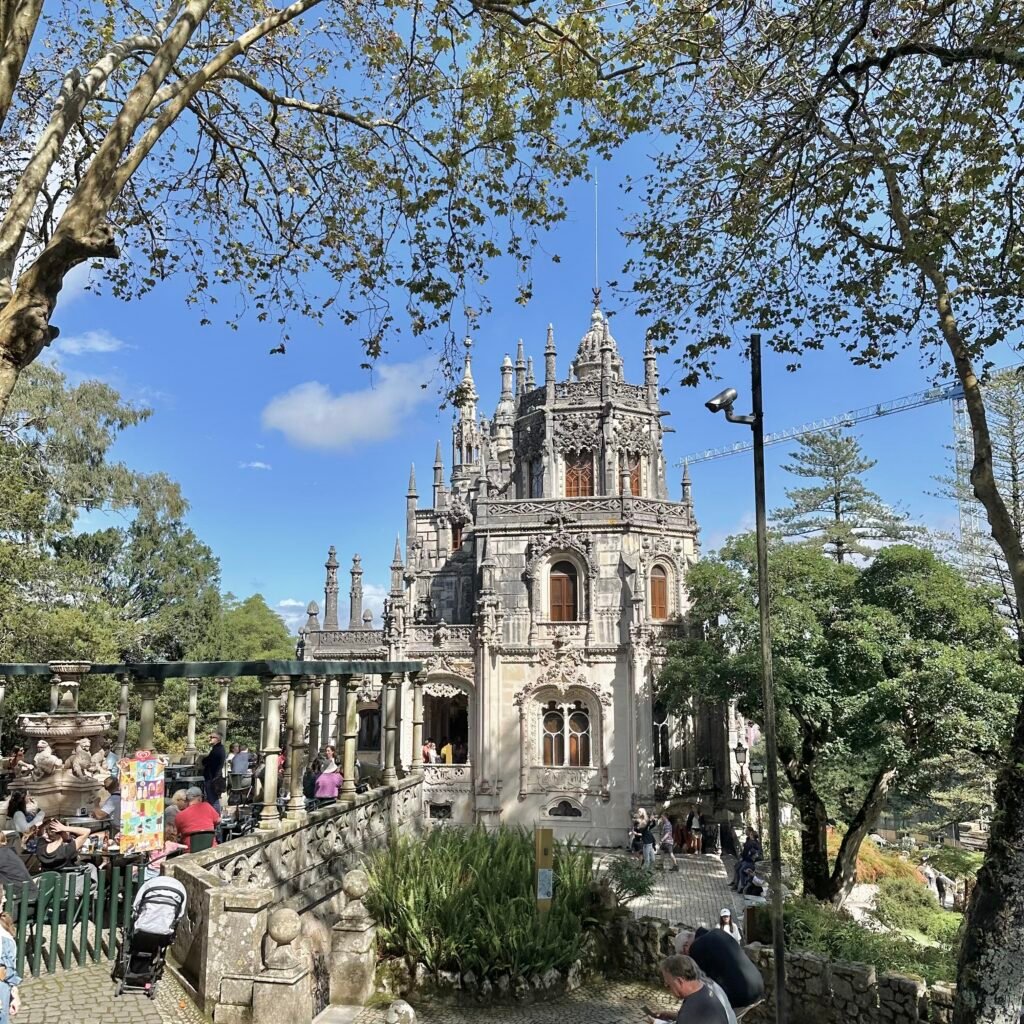
The garden inside Quinta da Regaleira is a true labyrinth of beauty and mystery. Filled with lush greenery, hidden paths, and enchanting features like grottoes, fountains, and whimsical sculptures, the garden feels like stepping into a fairytale. As you wander through, you’ll discover magical spots like the Chapel of St. John the Baptist, the beautiful lakes, and secretive nooks that seem to hold ancient stories. Every corner of the garden is designed to evoke wonder, with the perfect blend of nature, art, and symbolism. It’s a peaceful, otherworldly escape that will leave you spellbound.
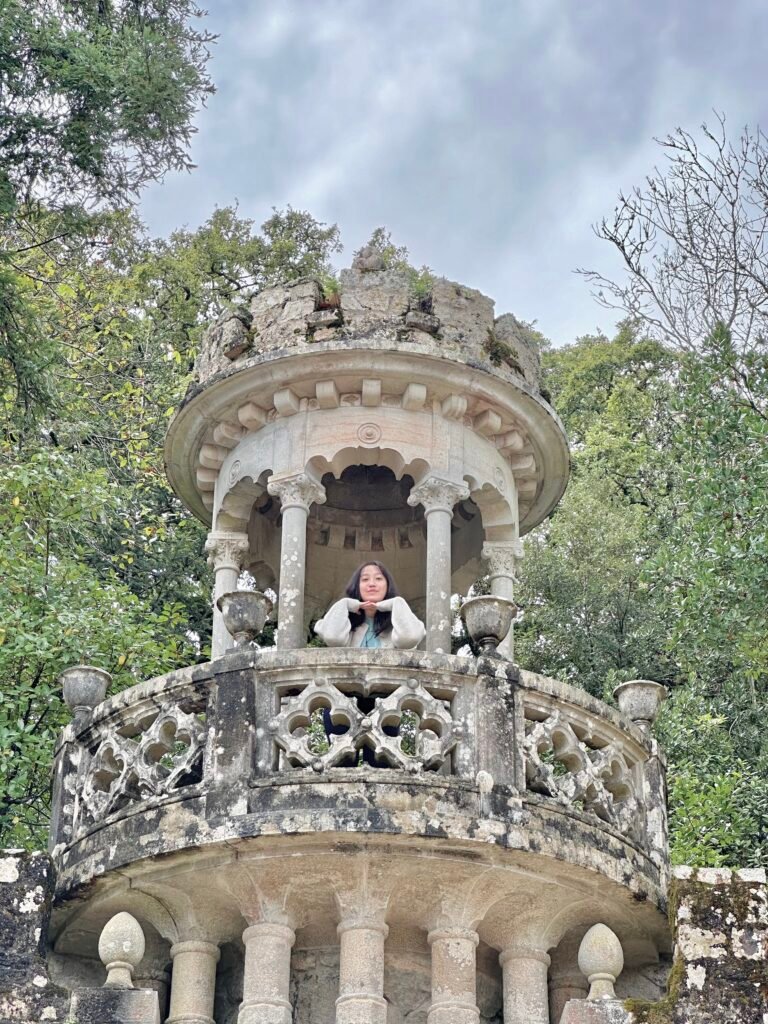

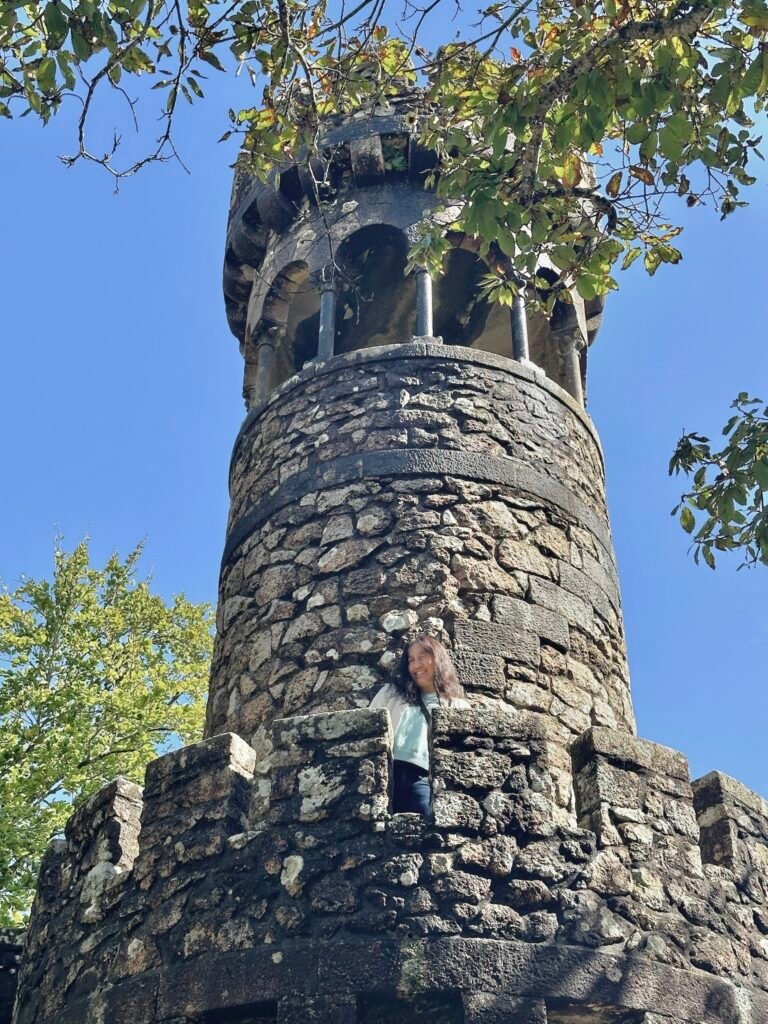

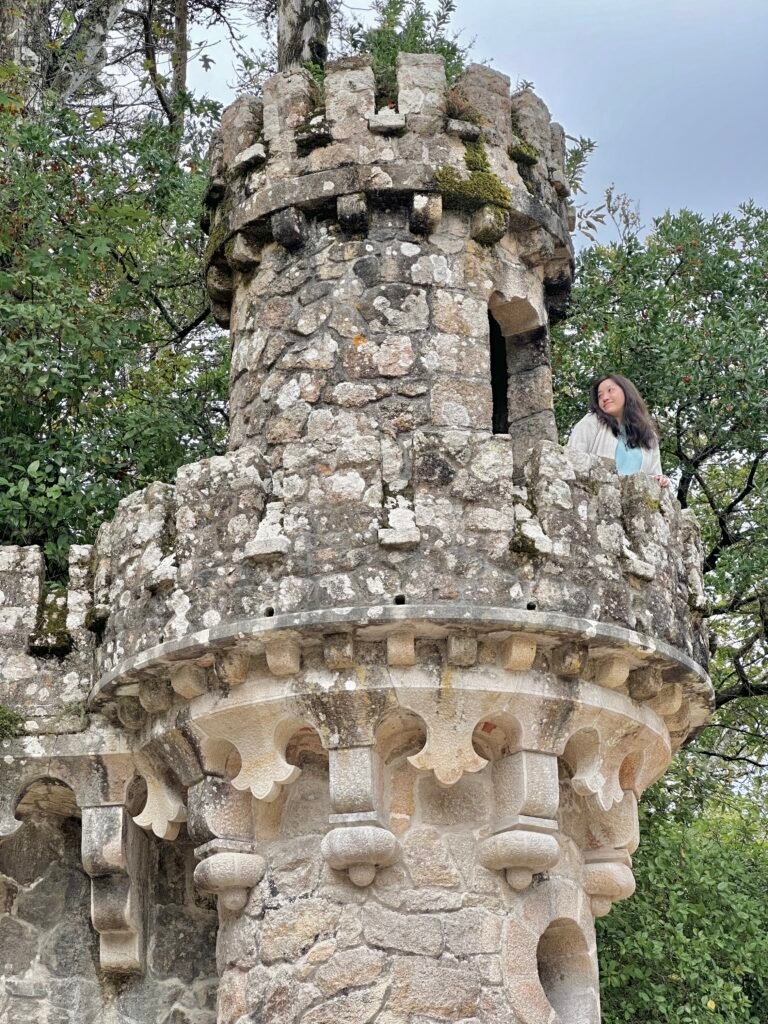
Lastly, we can’t visit Quinta da Regaleira without mentioning the Initiation Well — it’s a mystical, spiraling descent into the unknown. This inverted tower, with its nine levels, is believed to symbolize a journey of rebirth, inspired by Masonic and alchemical traditions. As you walk down the eerie stone staircase, surrounded by moss-covered walls, you’ll feel as if you’re stepping into a secret world, surrounded by whispers of ancient secrets. At the bottom, hidden tunnels await, further enhancing the allure of this enchanted place.
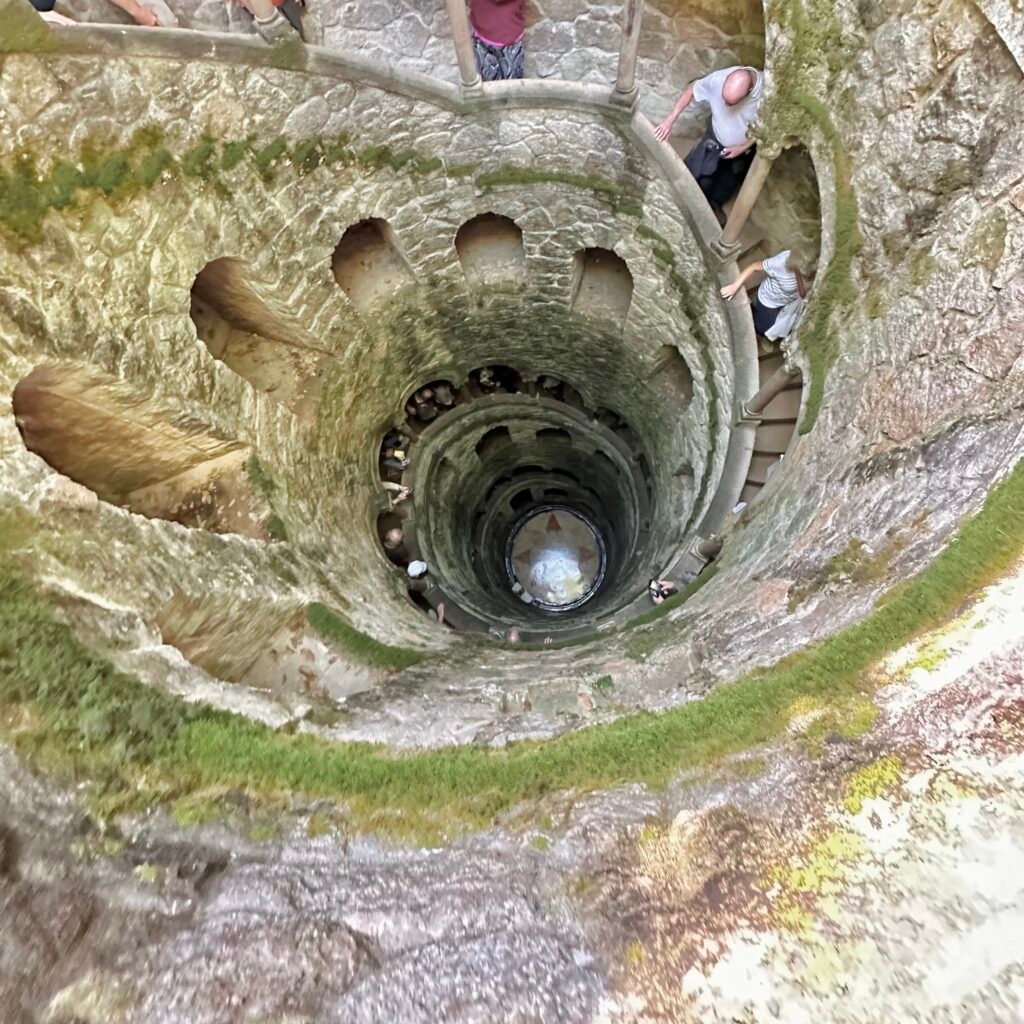

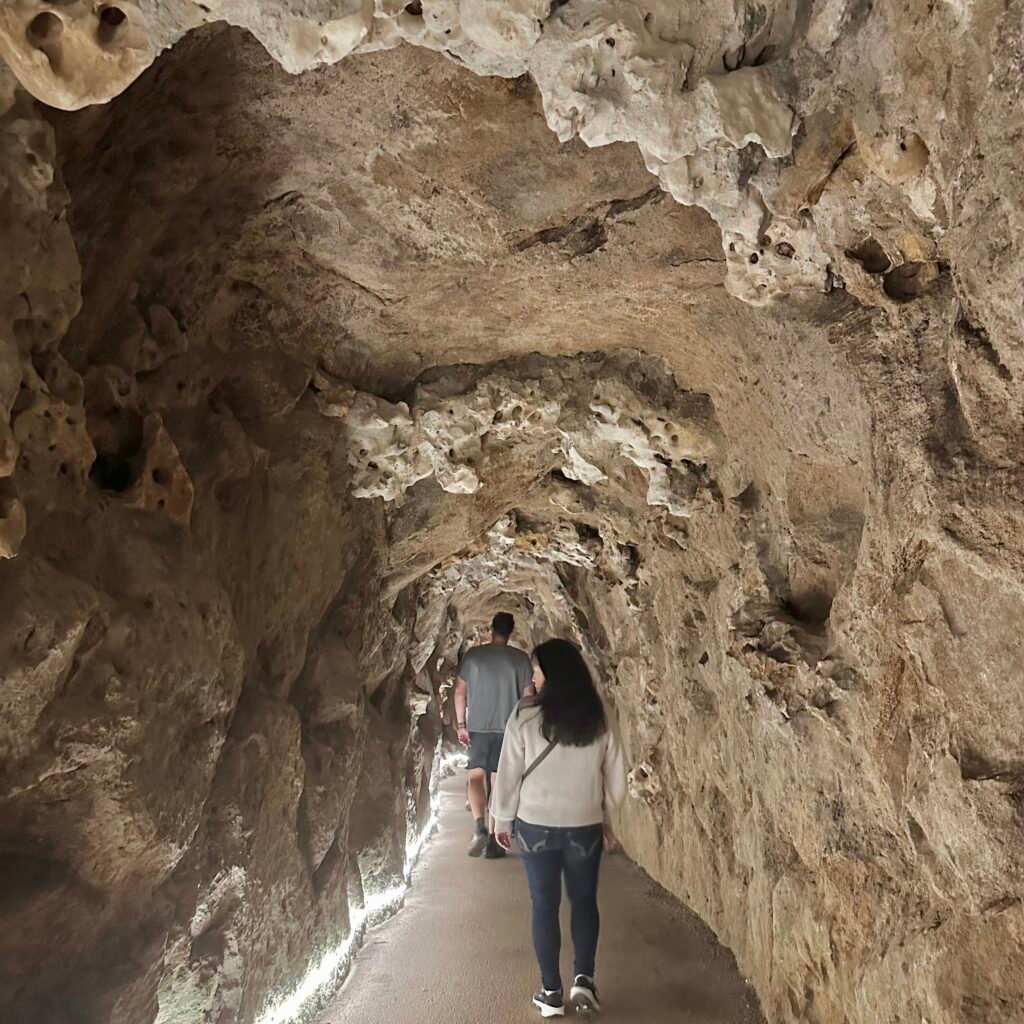
Opening Hours & Admission
Quinta da Regaleira opens between 10am – 7:30pm from April to September, and 10am – 6:30pm rest of the year, with the last admission time at 5:30pm. The admission ticket are timed, unless you are booking a guided tour. You can purchase your tickets from €19 to €30 here, depending on whether you want to join the guided tour. (You can get the audio guide ticket for €23.90)
As one of the most iconic castle in Sintra alongside with the National Palace of Pena, Quinta da Regaleira can get quite crowded, so I highly recommend purchasing the earliest ticket (10:30am) ONLINE. Not only will this save you time, but it will also give you the chance to enjoy the Initiation Well all to yourself, making for a more peaceful and immersive experience.
Palace of Monserrate
The Palace of Monserrate is a stunning blend of Gothic, Moorish, and Indian architectural styles, set within a lush, sprawling park in Sintra. Built in the 19th century for the English merchant Sir Francis Cook, the palace is a true masterpiece. Its intricate design, including delicate arches, exotic gardens, and ornamental details, transports you to a fairy-tale world. The surrounding gardens are filled with rare plant species from around the globe, making it a serene and captivating escape. It’s a must-visit for anyone wanting to experience Sintra’s romantic and eclectic charm.


Opening Hours & Admission
The Palace of Monserrate opens between 9:30am – 6pm, with the last admission time at 5:30pm. You can purchase your tickets for €12 here, and get a 15% discount if you purchase at least 3 days in advance.
We didn’t have enough time to visit the Palace of Monserrate this time, but knowing its unique blend of architectural styles and enchanting gardens, I know it’s a place worth exploring. I’ll definitely add it to my itinerary next time I visit Portugal!
Alternative Suggestions For Day 4
Most visitors spend around 2 to 3 hours exploring Quinta da Regaleira, but the duration can vary depending on your pace and interest. With its enchanting gardens, hidden tunnels, and the mystical Initiation Well, there’s so much to explore. If you love photography, secret pathways, or simply soaking in the fairytale atmosphere, you could easily spend 4 hours or more here. To truly enjoy the magic without feeling rushed, I’d recommend giving yourself plenty of time to wander, discover, and get lost in the mystery of this incredible place.
If you’re not driving or have limited days in Portugal, I’d suggest skipping Day 5’s itinerary and instead taking a direct bus to Porto from here in Sintra. The journey takes roughly 4 hours, meaning you’ll arrive in Porto by evening—just in time to enjoy a delicious dinner and get a good rest before diving into Day 6’s itinerary the next morning. This way, you can save time and start fresh in Porto without feeling rushed!
Day 5: Alcobaça, Tomar, Coimbra & Luso
If you’re a second-time visitor or simply want to immerse yourself in Portugal’s medieval charm, consider following this Day 5 itinerary. It takes you through historic towns, ancient castles, and stunning monasteries, offering a deeper and more authentic experience beyond the usual tourist hotspots.
Monastery of Alcobaça
The Monastery of Alcobaça, a UNESCO World Heritage site, stands as one of Portugal’s finest Gothic masterpieces. Founded in 1153 by King Afonso I, this monumental Cistercian monastery reflects centuries of history. Its vast, serene nave and intricate stone carvings exude timeless beauty. The monastery is most renowned for the poignant tombs of Pedro and Inês, whose ill-fated love story remains a symbol of passion and tragedy. Their tombs, intricately sculpted and placed side by side, are a hauntingly beautiful tribute to a love that defied time, making this historic site even more unforgettable.
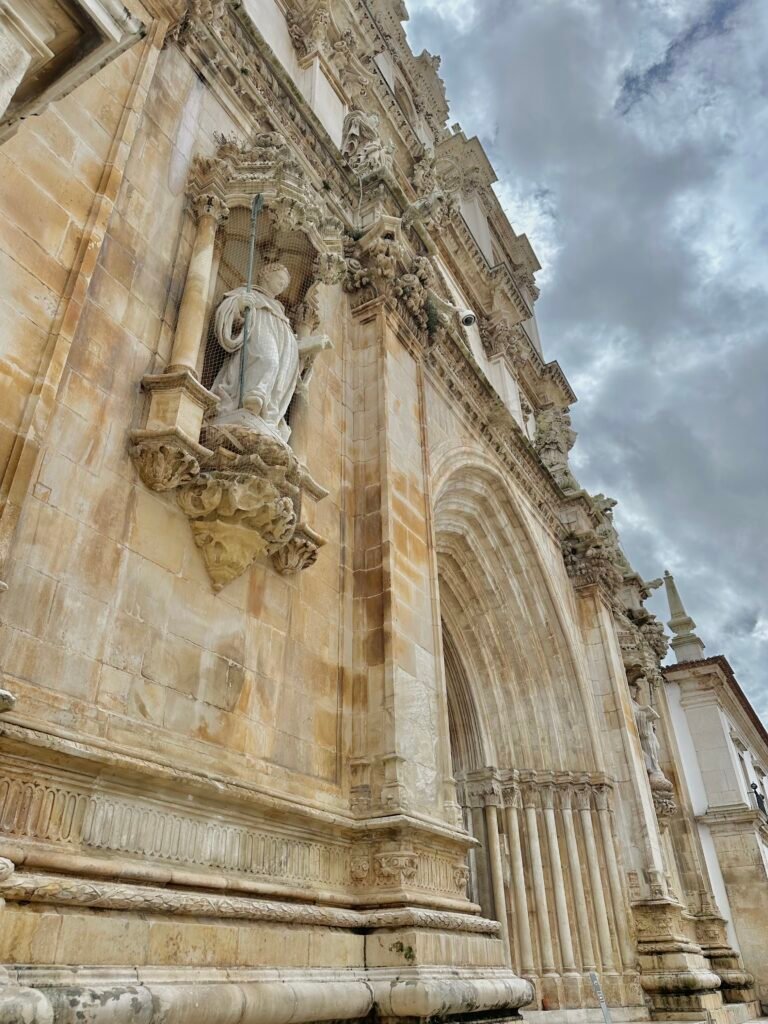


It was a rainy day when we arrived at the Monastery of Alcobaça, and we couldn’t have asked for a better time to visit. With fewer visitors braving the weather, we practically had the entire monastery to ourselves. It felt almost magical as we quietly wandered through the vast spaces, soaking in the serene atmosphere. We couldn’t help but overhear the guided tours of a few other visitors, which gave us fascinating insights into the history and architectural details we might have missed. The rain only added to the experience, creating a peaceful, timeless sanctuary that felt like it belonged to us alone.
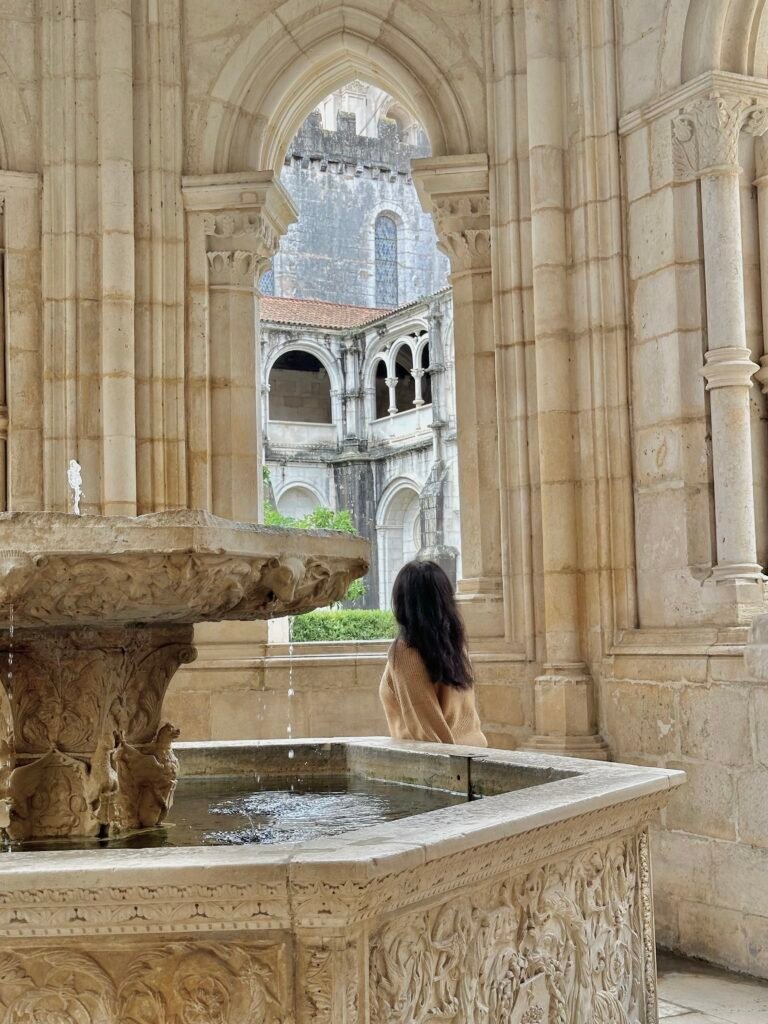


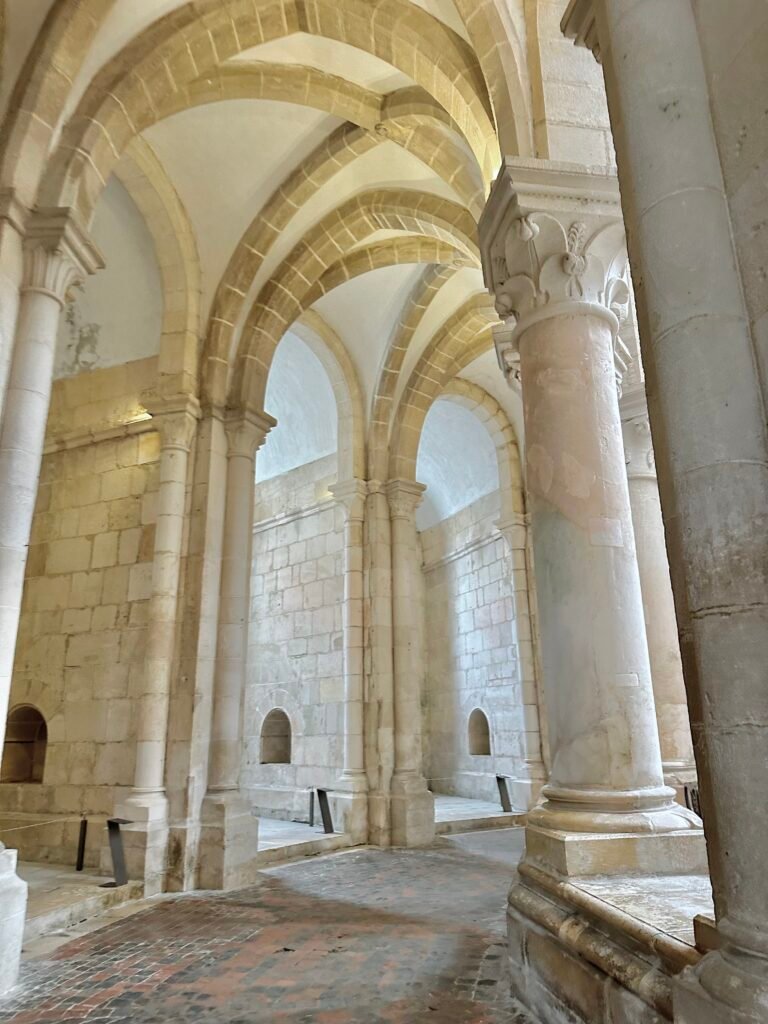
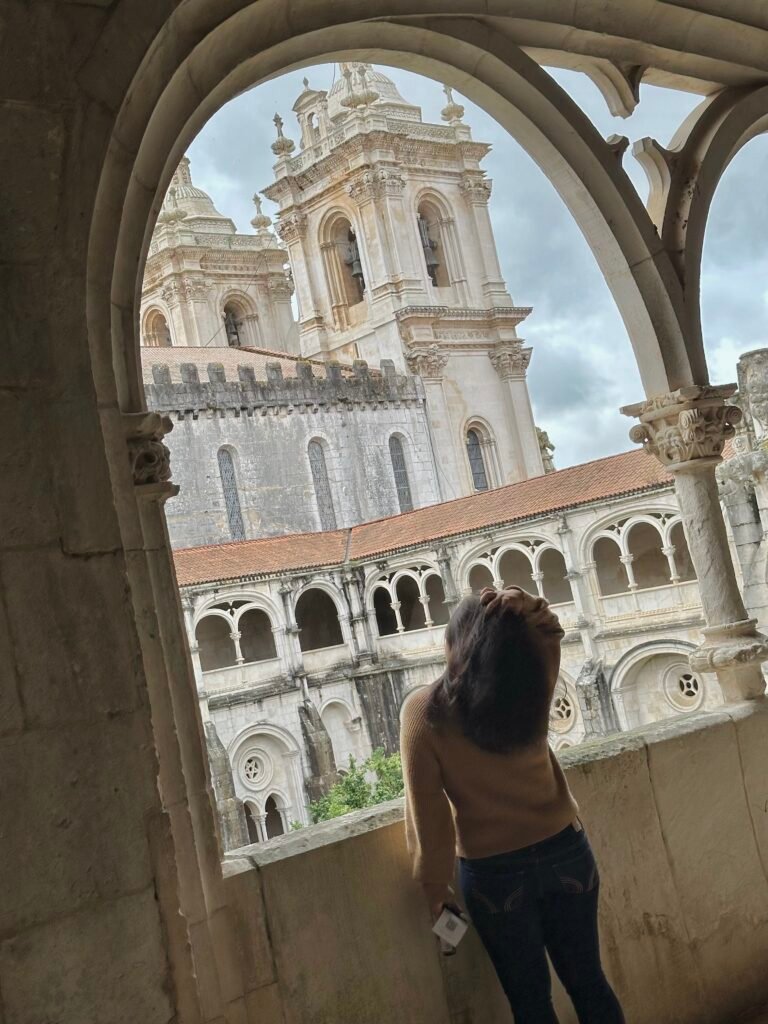

Opening Hours & Admission
Admission ticket for Monastery of Alcobaça is €15 for adults, free of charge if you have the Lisboa Card with you. It is open between 9am – 6pm from October to March, and between 9am – 7pm from April to September, where the last admission is 30 minutes before the closing time.
Batalha Monastery
Gazing out at the rolling hills and distant mountains during our 30-minute drive from Alcobaça, we soon arrived at the awe-inspiring Batalha Monastery, a true masterpiece of Portuguese Gothic and Manueline architecture. Built to honor Portugal’s victory in the Battle of Aljubarrota (1385), this UNESCO World Heritage site took over a century to complete. Walking through its grand façade, we were mesmerized by the intricate stone carvings, towering arches, and delicate tracery that adorn its walls. Especially the Unfinished Chapels, left incomplete despite decades of work, stand as a hauntingly beautiful reminder of history. This monastery is not just a place of worship but a symbol of Portugal’s resilience and artistic excellence.


Opening Hours & Admission
Admission ticket for Batalha Monastery is €15 for adults, free of charge if you have the Lisboa Card with you. It is open between 9am – 6pm from October to March, and between 9am – 6:30pm from April to September, where the last admission is 30 minutes before the closing time.
University of Coimbra
As you drive further up, you’ll soon find yourself at the historic University of Coimbra, one of Portugal’s most prestigious institutions and a UNESCO World Heritage site, perched majestically on a hill. Founded in 1290, it is one of the oldest universities in Europe, steeped in history and tradition.


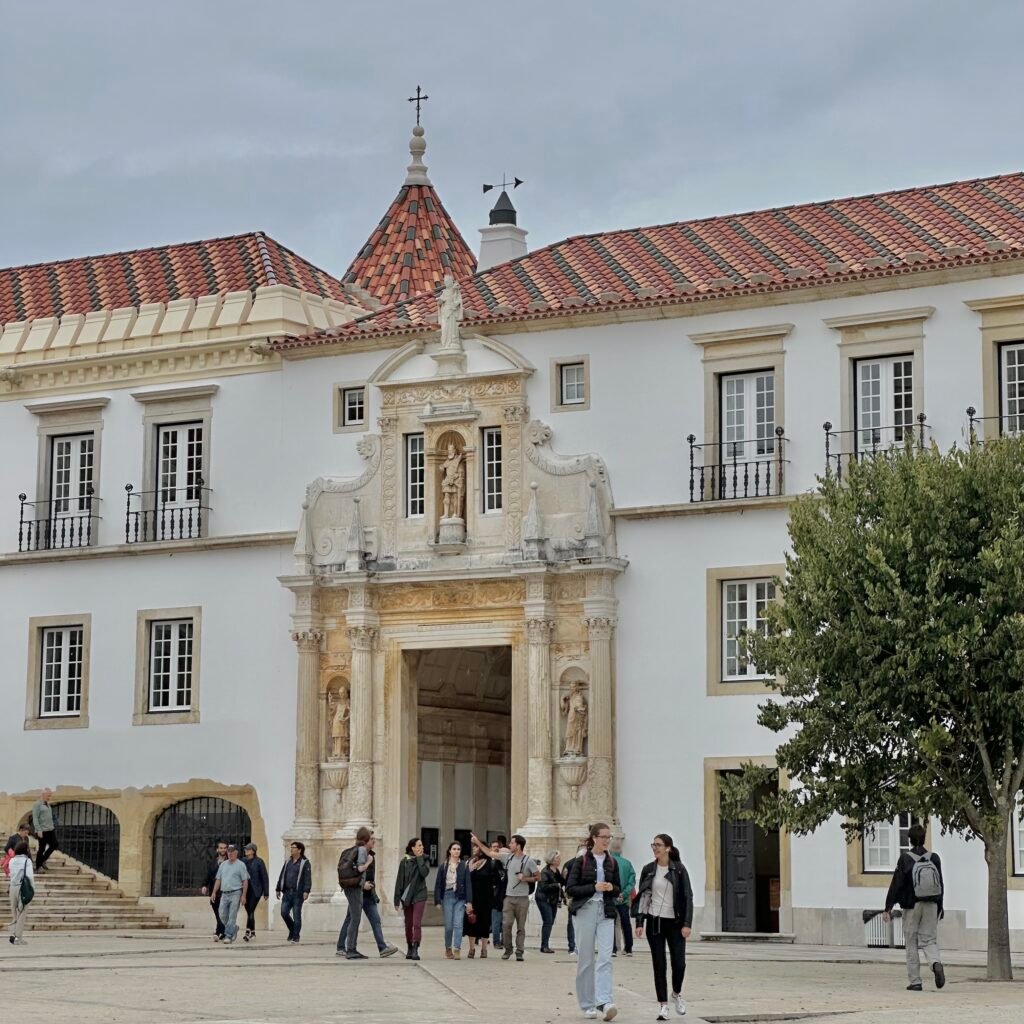
As we strolled through the university’s main plaza, taking in the beauty of the ancient buildings around us, we soon arrived at the magnificent Joanina Library. This 18th-century Baroque gem houses thousands of ancient books, with its gilded baroque interiors and frescoed ceilings, feels like stepping into a royal chamber of knowledge.


Opening Hours & Admission
Admission ticket for Joanina Library is €16.50 for adults, which includes the Palace of School (Baroque Library, St. Michael’s Chapel, the Royal Palace), the Chemistry Laboratory, the Cabinet of Curiosities and the Academic Museum. Tickets are available between 9am – 4:40pm. Unfortunately, by the time we reached the Joanina Library, the tickets had already sold out. To avoid the same mistake, I highly recommend booking your tickets online in advance to secure your spot!
Buçaco National Forest
Buçaco National Forest is a stunning natural sanctuary in central Portugal, rich in history and biodiversity. Once a monastic retreat, this enchanted forest is home to towering ancient trees, exotic plant species from around the world, and serene walking trails that lead to hidden chapels and fountains. This was one of the highlights I was most eager to explore before our trip. Unfortunately, the weather had other plans — heavy rain greeted us on arrival, and continued into the next day as we headed to Porto early in the morning. I couldn’t explore the forest as I imagined, but rest assured, I’ll be back to discover its hidden gems next time!

Bussaco Palace (Hotel)
At its heart stands the magnificent Buçaco Palace, a neo-Manueline masterpiece that adds a touch of fairytale charm. Luckily we stayed here, which turned out to be a beautiful refuge from the rain. While the weather kept us from exploring the forest, we were able to wander through the palace’s grand interiors. The Buçaco Palace itself is a stunning blend of architectural styles, with its ornate details, elegant rooms, and regal atmosphere. Originally built as a royal hunting lodge in the 19th century, it is now a luxurious hotel where history and modern comfort coexist beautifully. Even on a rainy day, the palace offered us a glimpse into Portugal’s royal past, making our stay unforgettable despite the weather.







Day 6: Porto
I can hardly believe it’s already our last day in Portugal (or the second-to-last for those skipping Day 5’s itinerary). After a scenic 1.5-hour drive from Buçaco, we finally arrived in Porto, where the city’s charming streets immediately captivated us.
Majestic Café
If you’re looking for a taste of Porto’s history and elegance, look no further than Majestic Café. Dating back to 1921, this iconic café is a masterpiece of Belle Époque design, boasting ornate chandeliers, intricate woodwork, and a timeless charm that makes you feel like you’ve stepped into another era. Once frequented by intellectuals and artists, Majestic Café remains a symbol of Porto’s cultural heritage. Interestingly, it’s also said to have been a favorite spot of J.K. Rowling during her time in the city, where she is believed to have drawn inspiration for some elements of the Harry Potter series.
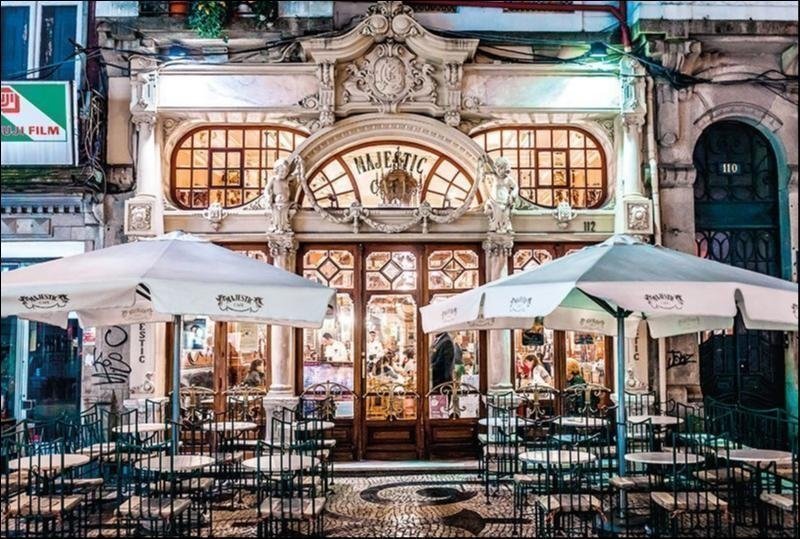

We didn’t get the chance to go inside Majestic Café due to the long queue in the afternoon, but I highly recommend visiting early in the day when it first opens at 9am. That way, you can enjoy a peaceful coffee break while admiring the café’s stunning interior. As the day progresses, it can get quite crowded, so arriving early will help you fully appreciate its elegance without the rush!
Clérigos Church
Finally our official first stop – the iconic Clérigos Church, a must-see gem in Porto. Clérigos Church, with its towering baroque bell tower, is one of Porto’s most recognizable landmarks. Built in the 18th century, the church’s ornate interior is a stunning example of baroque architecture, with intricate carvings, golden altars, and detailed frescoes. The highlight of the church is undoubtedly its bell tower, Torre dos Clérigos, which offers panoramic views of the city once you climb to the top. Whether you’re admiring the church’s beauty from below or taking in the view from above, Clérigos Church is an essential stop in Porto.
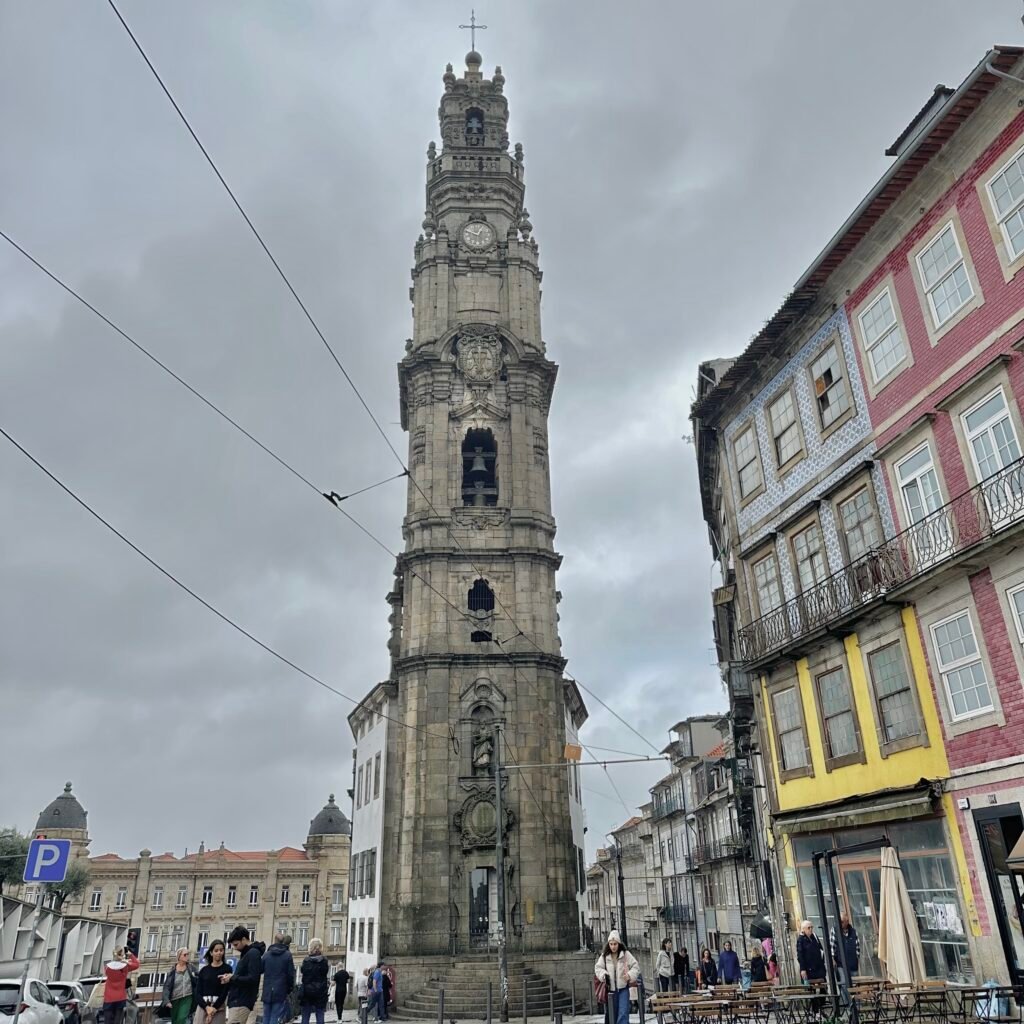





Opening Hours & Admission
Entrance to the church is free, but if you wish to go up the tower, admission Day Ticket including the museum is €10, opening from 9am – 7pm. Night Ticket, where museum is not inlcuded, available only on special dates (Easter, Summer and Christmas season) is €5 for adults, opening from 7pm – 11pm.
Livraria Lello
A visit to Porto wouldn’t be complete without stepping into Livraria Lello, often regarded as one of the most beautiful bookstores in the world. This architectural masterpiece, dating back to 1906, is a blend of neo-Gothic and Art Nouveau styles, with its stunning staircase, intricate woodwork, and colorful stained-glass windows. Known for inspiring J.K. Rowling’s depiction of Hogwarts, the bookstore exudes a magical atmosphere that’s both enchanting and rich in history.





However, by the time we visited around 2:30pm, the bookstore was already packed with visitors. With so many people inside, it wasn’t exactly the best place to enjoy a quiet reading moment. That said, it’s still worth a visit to admire the breathtaking interior, from the intricate woodwork to the grand staircase and stunning stained-glass ceiling. Even if you can’t fully immerse yourself in the books, the architectural beauty alone makes Livraria Lello an unforgettable stop in Porto.
Opening Hours & Admission
Admission ticket for Livraria Lello ranges from €15-50, including a Ticket-Voucher discounted / valued with the purchase of a book. It is open between 9am – 6pm.
Porto São Bento
As you browse through the charming indie boutiques lining the street, you’ll soon find yourself at Porto São Bento, one of Portugal’s most beautiful and historic train stations. Built on the site of a former Benedictine monastery, the station was officially inaugurated in 1916, blending Beaux-Arts architecture with intricate azulejo tilework. Stepping inside, you’ll be greeted by a breathtaking hall adorned with over 20,000 blue-and-white azulejos, painstakingly hand-painted by artist Jorge Colaço. These tiles depict key moments in Portugal’s history, from battles to royal processions, transforming the station into a true work of art. Whether you’re catching a train or just passing through, São Bento is a must-see for history and art lovers alike.





McDonald’s – Imperial
You may wonder — what’s so special about a McDonald’s? Well, McDonald’s Imperial in Porto is nothing like your typical fast-food chain. Housed in a former 1930s café, this McDonald’s is often hailed as the most beautiful in the world. Stepping inside feels like entering a grand European café, with dazzling chandeliers, intricate stained glass windows, and elegant Art Deco details that transport you back in time. Whether you’re stopping for a quick bite or simply soaking in the historic ambiance, this is easily the most luxurious setting you’ll ever enjoy a Big Mac in!


Palácio da Bolsa
If you still have time before dusk, you can visit Palácio da Bolsa, but make sure to leave enough time, as we had a secret and hidden spot we needed to head to for the sunset! This 19th-century building, once Porto’s stock exchange, is an architectural masterpiece. Its grand neoclassical façade welcomes visitors, but the real gem lies inside. The Arabian Room, with its intricate Moorish-inspired design, gilded details, and stunning stained-glass windows, will transport you to another world. The palace offers a glimpse into Porto’s rich history and opulence, and if you’re lucky, you might catch one of the fascinating guided tours to learn more about its cultural significance.
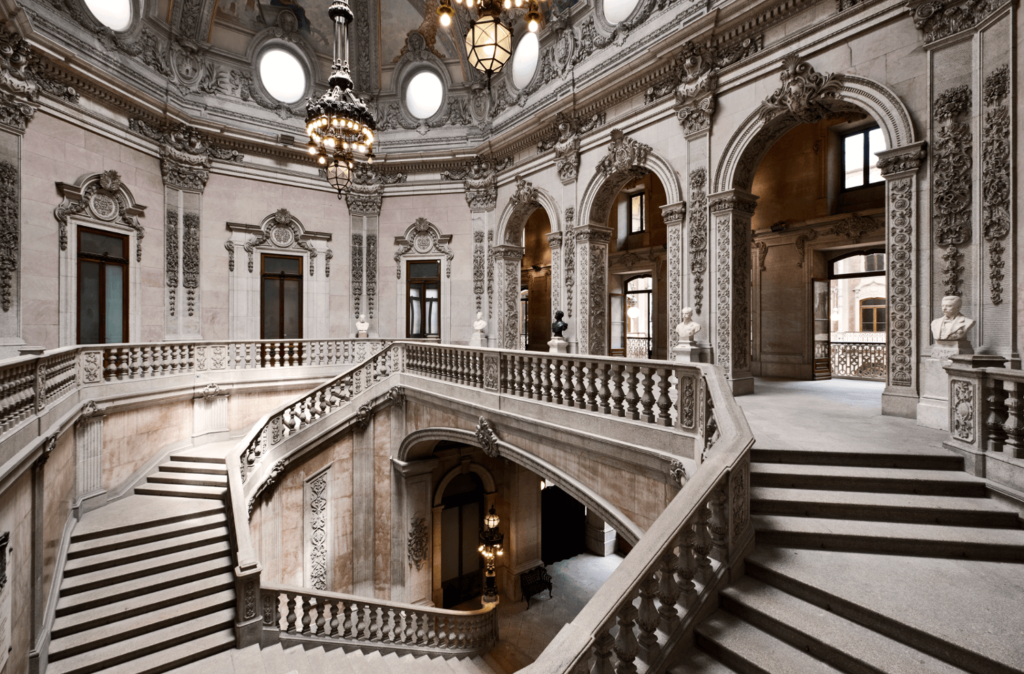

Opening Hours & Admission
Admission ticket for Palácio da Bolsa is €14 for adults, it is open between 9am – 6:30pm.
Luís I Bridge
Finally, we arrived at the main highlight of our day—the stunning Luís I Bridge, the secret gem I’ve been hinting at for watching the sunset. This iconic double-deck iron bridge, designed by a student of Gustave Eiffel, offers some of the most breathtaking views in Porto. Spanning the Douro River, the bridge connects the historic Ribeira district to Vila Nova de Gaia, and as the sun sets behind the city, the landscape transforms into a golden panorama. Whether you’re walking across the top deck for an elevated view or strolling along the lower level, the scene is absolutely magical, especially when bathed in the warm hues of the setting sun. It’s the perfect way to end your day in Porto!
On the Bridge
Walking across the Luís I Bridge is one of the best ways to truly experience its grandeur. From here, you’ll be treated to breathtaking panoramic views of Porto’s colorful riverside, the shimmering Douro River, and the charming rooftops of Vila Nova de Gaia. But what makes this walk even more thrilling is the metro train passing right beside you, so close that you can feel the rush as it glides by. It’s a unique mix of history, engineering, and urban life all in one unforgettable stroll!


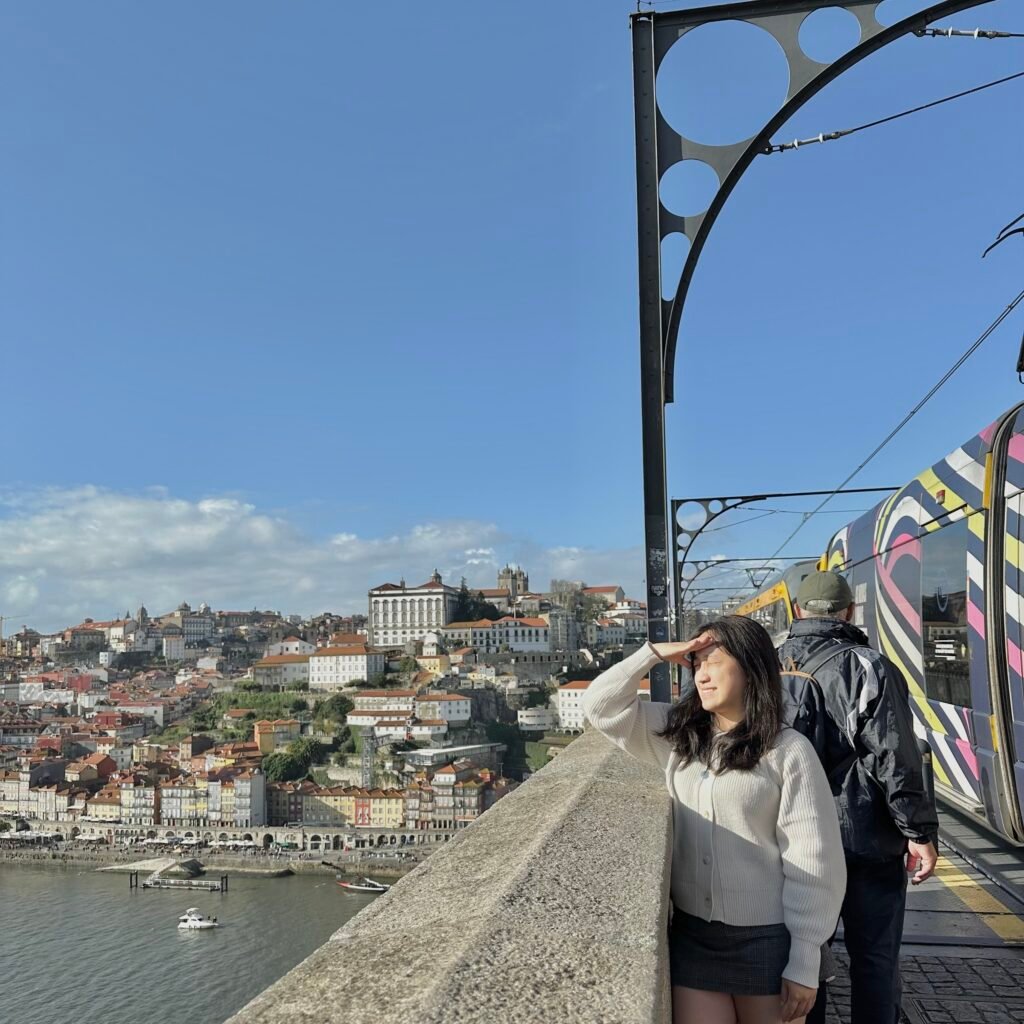

Under the Bridge
For a completely different perspective, head down to the riverside and admire the Luís I Bridge from below. Try googling “Vincci Ponte de Ferro” and then walk down the narrow street on the right. Standing along the banks of the Douro, you’ll get a true sense of its massive iron structure stretching high above you. This is also where you can take a traditional rabelo boat ride, once used to transport wine barrels, and glide right under the bridge for a stunning waterside view. Whether you’re watching the reflections on the river or capturing the bridge’s towering silhouette at sunset, this angle adds a whole new layer to the experience.


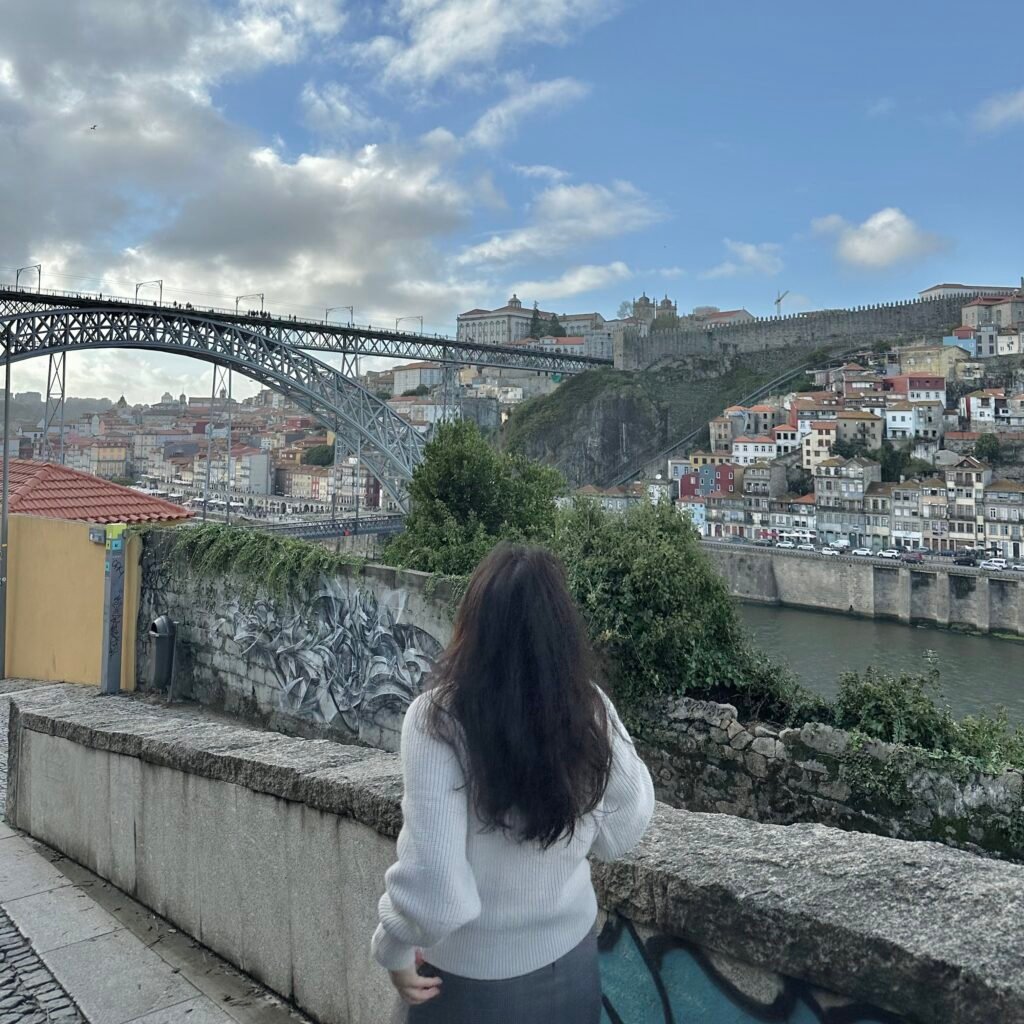


Underneath the Bridge
For a hidden and less conventional way to experience the Luís I Bridge, venture underneath it, where you’ll find quiet nooks and pathways with a raw, industrial charm. Some staircases and tunnels lead to unexpected viewpoints, offering a different appreciation of its iron framework from a closer, almost secretive perspective. If you’re feeling adventurous, you can even grab a drink at one of the riverside bars tucked beneath the bridge, where you can soak in the atmosphere with a spectacular backdrop of the illuminated arches above.


Above the Bridge
For the most breathtaking view, head up to the Serra do Pilar Monastery, perched on a hill above the bridge. From this vantage point, you’ll get a sweeping, postcard-perfect panorama of Porto, the Douro River, and the entire length of the Luís I Bridge. As the sun sets, the city lights begin to twinkle, and the bridge glows against the night sky—making this the ultimate spot to take in Porto’s magic from above.
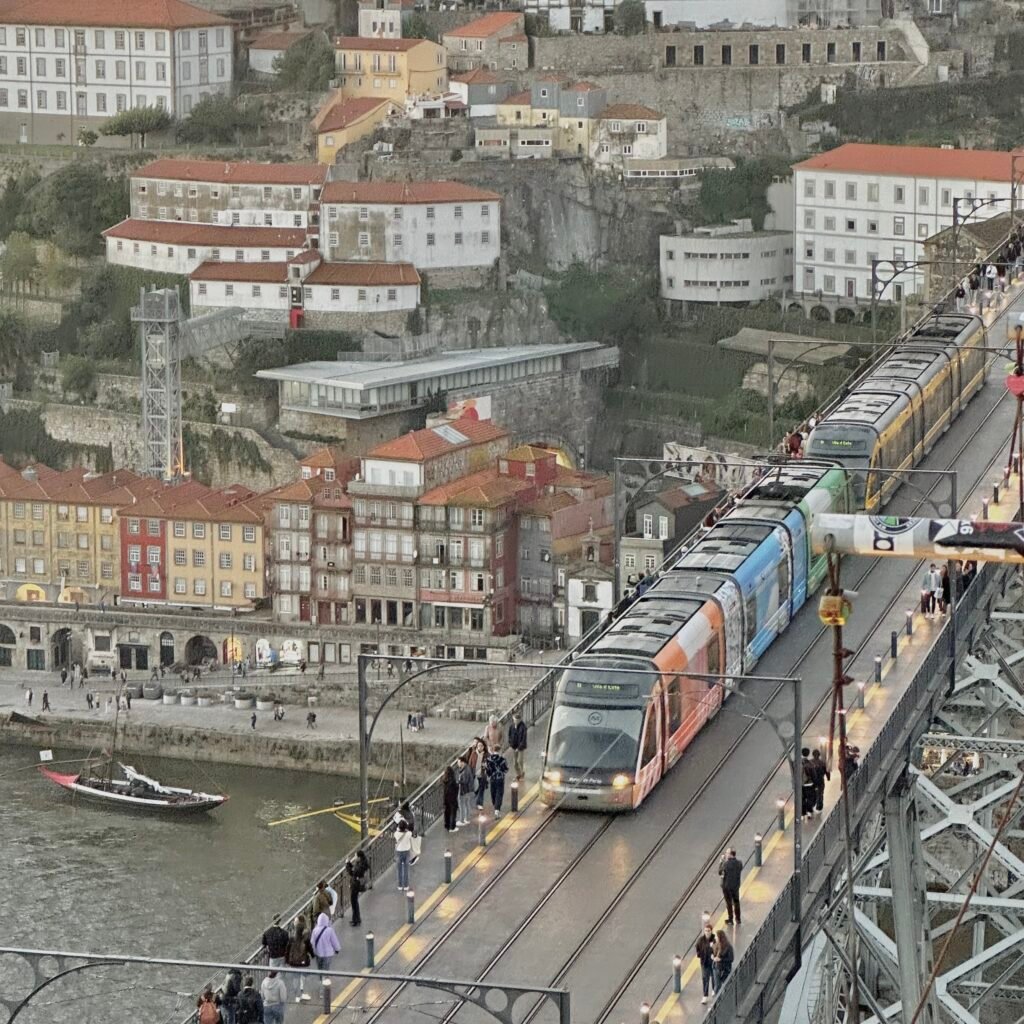




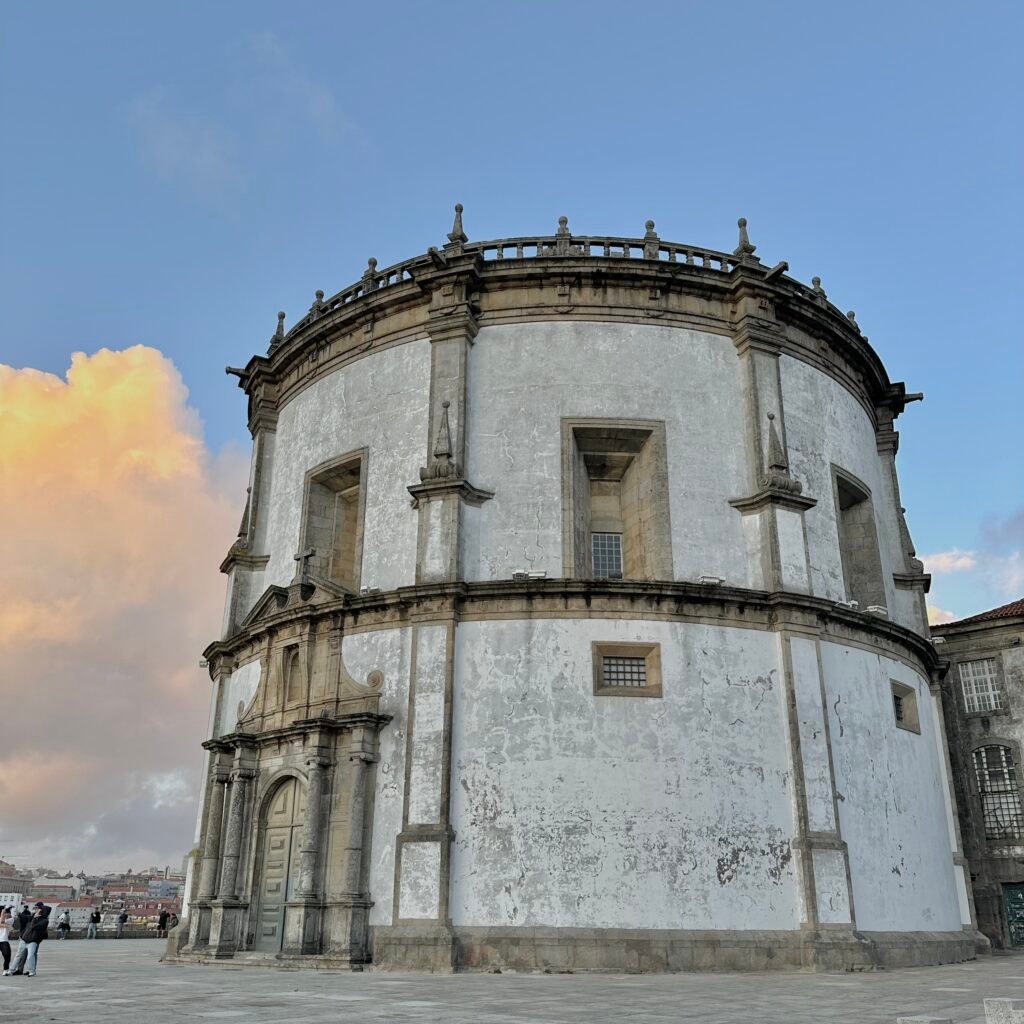
We had the best stay here in Porto, and our apartment couldn’t have been more perfect — even for families! From the cozy ambiance to the well-thought-out amenities, everything made us feel right at home. The best part? We could see the stunning Luís I Bridge right from our window! I’ll share more details about this amazing stay here, but we’re beyond glad that we chose this place — it truly made our time in Porto even more special.
Alternative Itineraries For Portugal
Most of the places mentioned here are easily accessible on foot or just a few metro stops away, especially within Lisbon and Porto, while buses are the best way to get around Sintra. If you’re not driving, I’d recommend skipping Day 5 to fully immerse yourself in the vibrant streets of Lisbon and Porto.
Unfortunately, I didn’t have enough time on this trip, but Porto is also renowned for its wine. If you’re a fan, be sure to check out this blog — I’ll be following in your footsteps next time!
Here is a list of places I wanted to visit but couldn’t due to limited time. If you have extra days, feel free to consider these spots. Without further ado, let’s dive in!
Palace Fronteira
Palácio Fronteira is a stunning 17th-century palace in Lisbon, originally built as a hunting lodge for the noble Mascarenhas family, who still reside there today. The palace is best known for its exquisite azulejo tile panels, which depict historical and mythological scenes in vibrant blue and white. Inside, the richly decorated halls showcase elaborate frescoes, gilded woodwork, and antique furniture, offering a glimpse into Portugal’s aristocratic past. Outside, the manicured gardens, adorned with fountains, statues, and hidden grottoes, create a peaceful retreat away from the city’s hustle. A visit here feels like stepping into a world of art, history, and timeless elegance.
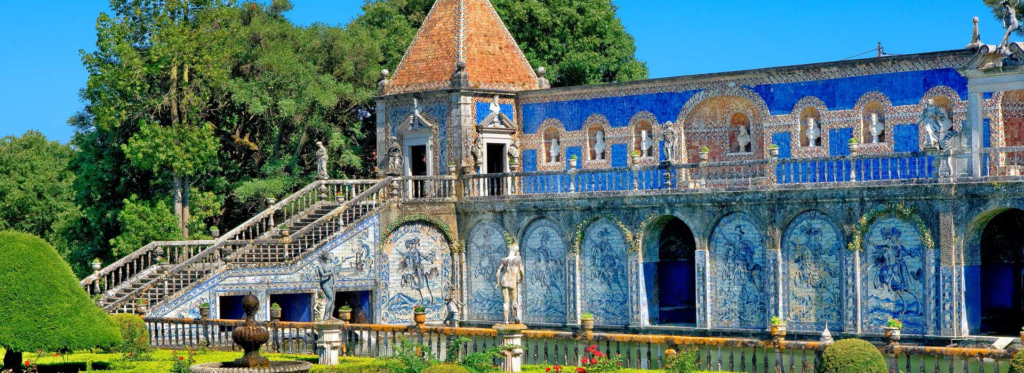
Church of Saint Dominic
The Church of Saint Dominic (Igreja de São Domingos) in Lisbon is a place of resilience and history. Originally built in 1241, this church has witnessed royal weddings, major events, and even devastating disasters. A powerful earthquake in 1755 and a massive fire in 1959 left the interior charred and damaged, but instead of restoring it to perfection, the church was left with its hauntingly beautiful, burnt-orange walls and cracked columns as a testament to its endurance. Stepping inside, you’ll feel an almost mystical atmosphere, surrounded by centuries of history and devotion. Despite the scars, it remains an active place of worship, standing as a symbol of Lisbon’s strength and perseverance. No admission charge to get in.
Basilica of Estrela
The Basilica of Estrela in Lisbon is one of the city’s most stunning religious landmarks, known for its grand dome and striking white façade. Commissioned by Queen Maria I in the late 18th century as a vow for giving birth to an heir, this basilica blends Baroque and Neoclassical styles, creating a majestic sight that dominates the skyline. Inside, you’ll find intricate marble patterns, ornate altars, and a breathtaking nativity scene made of cork and terracotta. For an even more unforgettable experience, climb to the rooftop for a panoramic view of Lisbon’s red rooftops and rolling hills.

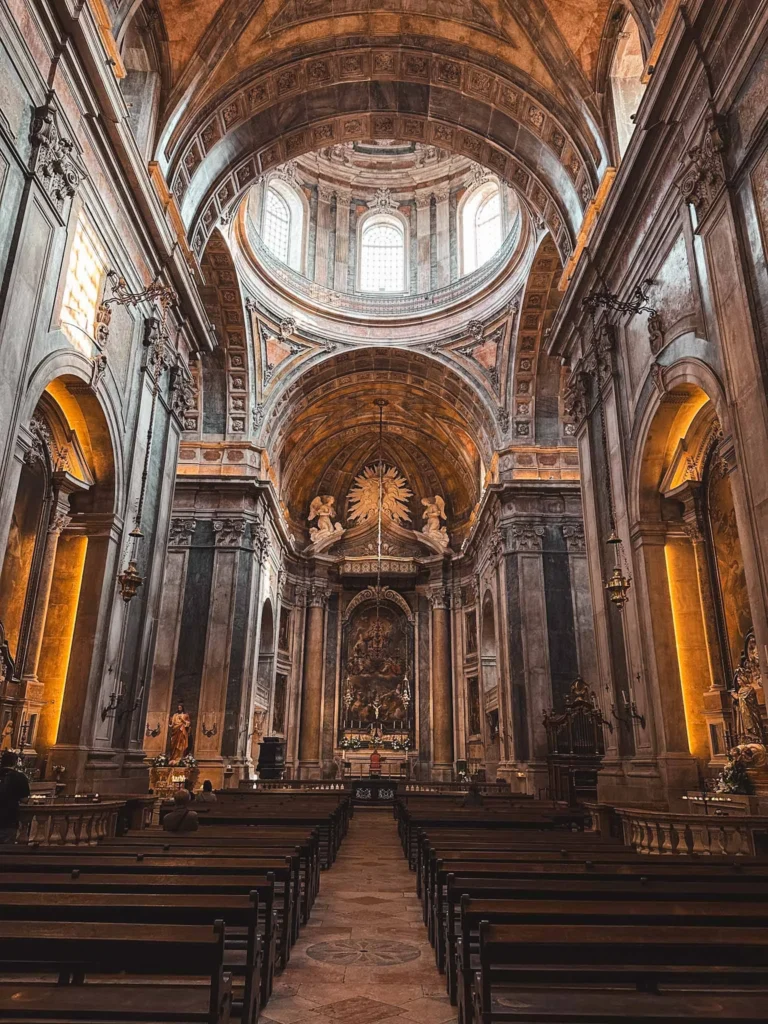
Cascais
Cascais, a charming coastal town just a short drive from Lisbon, is a perfect blend of history, culture, and stunning seafront views. Once a fishing village, it evolved into a glamorous retreat for Portuguese royalty and international visitors. Known for its beautiful beaches, vibrant marina, and historic sites like the Cascais Citadel and the Museu Condes de Castro Guimaraes, it offers a laid-back atmosphere with a touch of sophistication. With its quaint streets lined with cafes and boutique shops, Cascais is an idyllic destination for both relaxation and exploration.

Cabo da Roca
Cabo da Roca, located in Cascais, is the westernmost point of mainland Europe, is a breathtaking coastal destination that feels like the edge of the world. Towering 140 meters above the Atlantic Ocean, this dramatic cliffside offers sweeping views of rugged coastline, crashing waves, and endless horizons. Marked by a historic lighthouse and a stone monument inscribed with the famous words of Portuguese poet Luís de Camões, it’s a place of raw beauty and symbolism. Whether you’re here to admire the stunning landscapes or simply take in the salty ocean breeze, Cabo da Roca is a must-visit spot for nature lovers and adventurers alike.

More Travel Guides For Portugal
Coming Soon!






